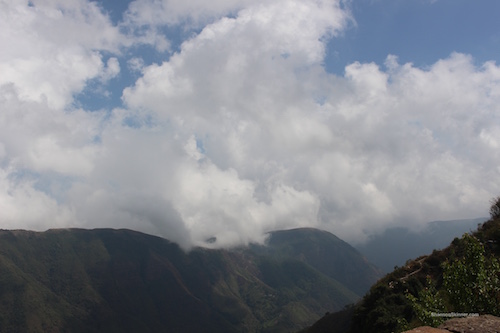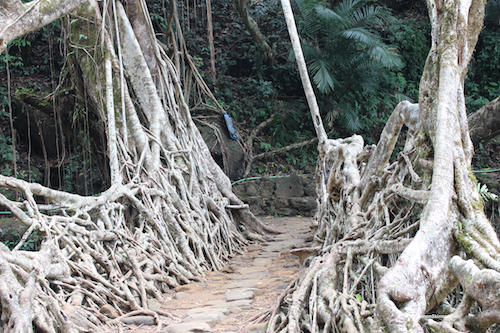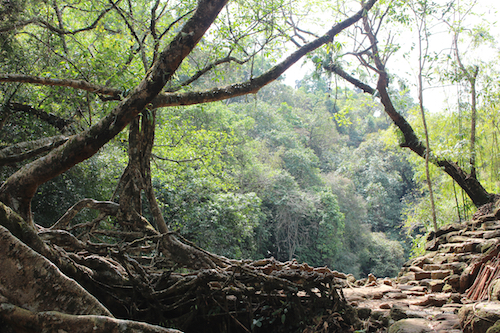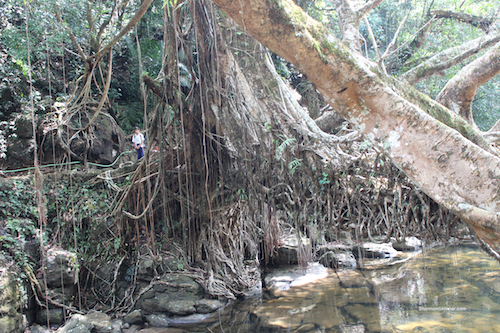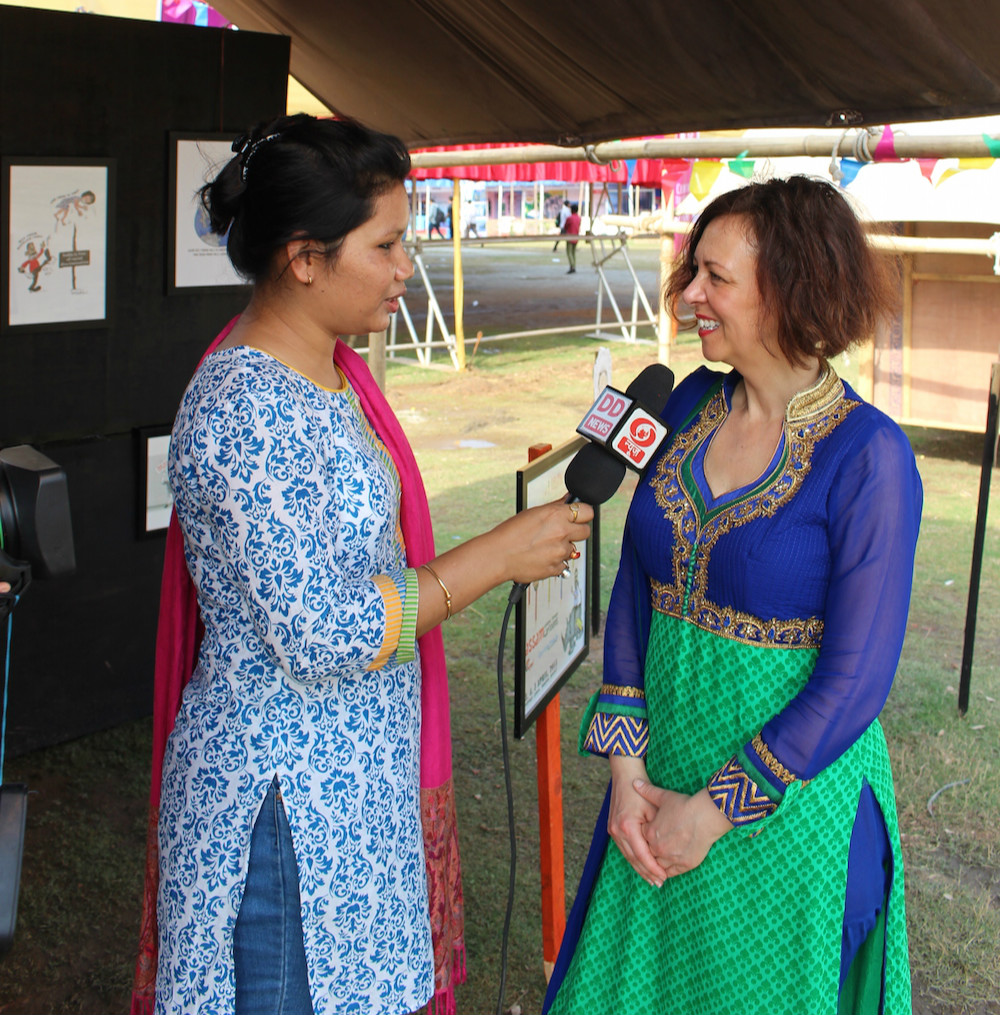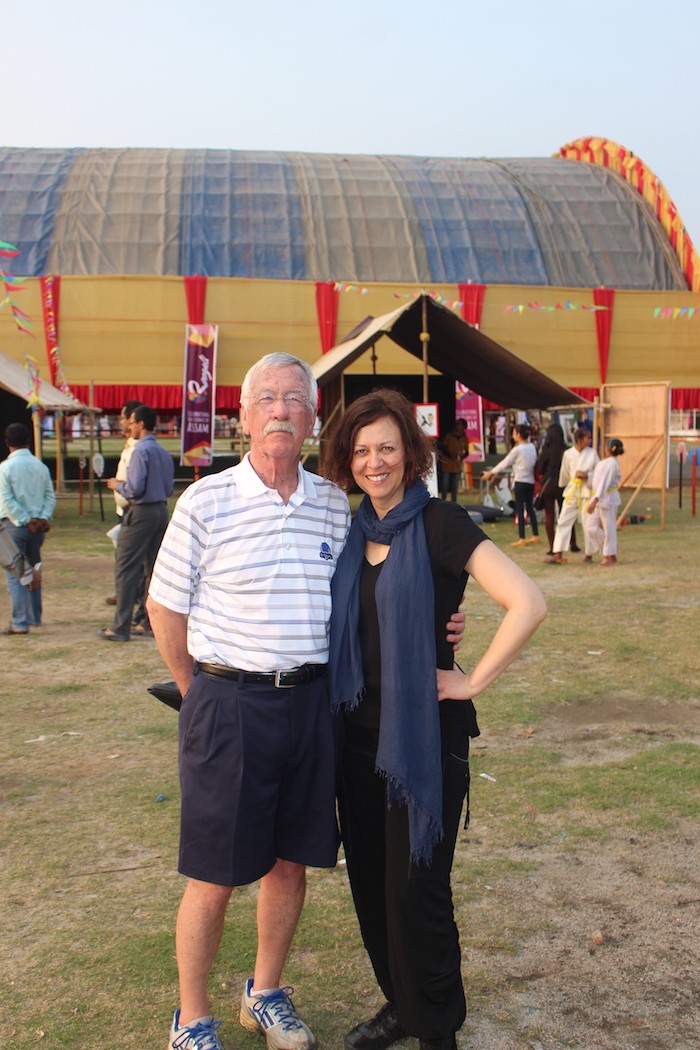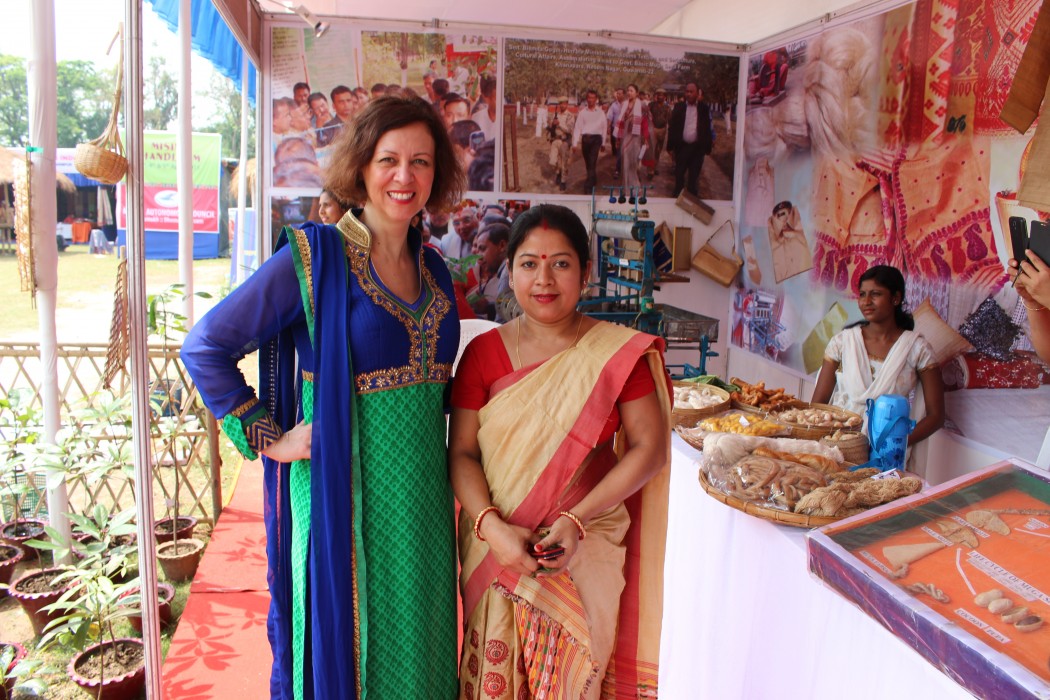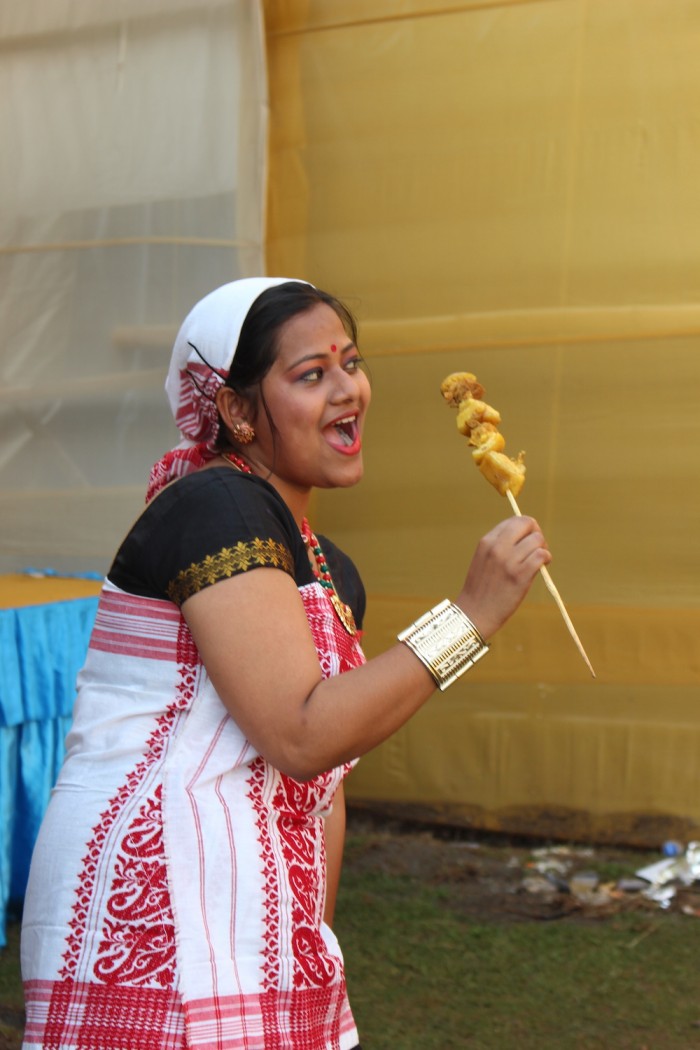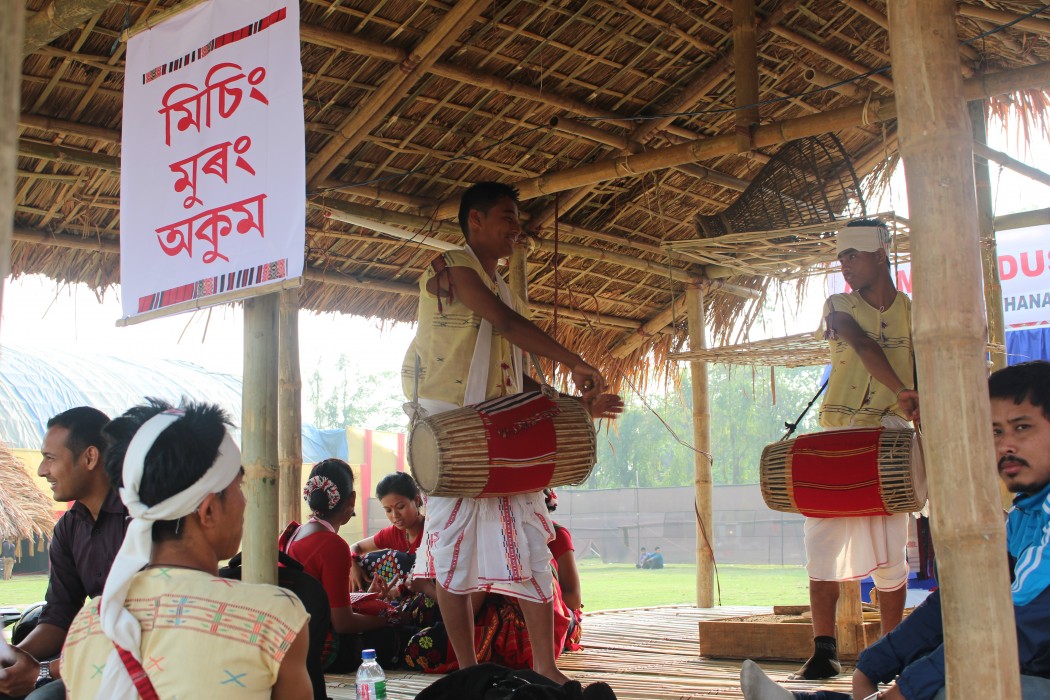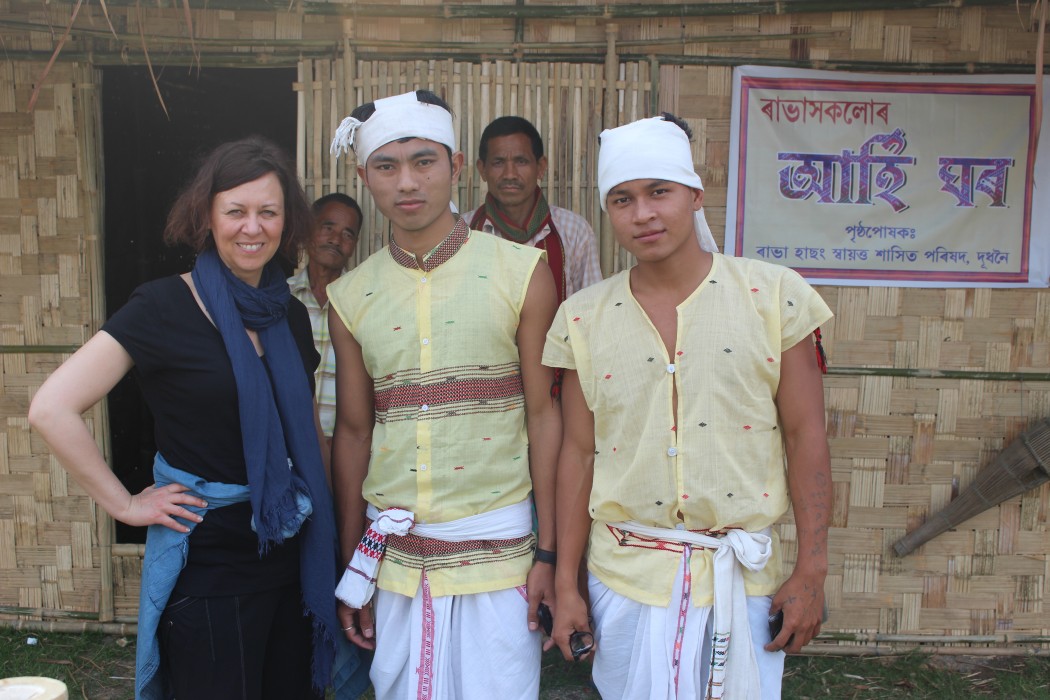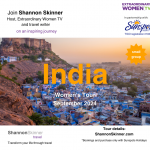The world’s 10 happiest countries to put on your travel ‘love list’
Would you visit the places where people are the happiest? As a traveller, this sounds ideal because while every country has its own beauty and hidden gems, it is always the people, to me anywhere, that make or break a trip.
This past Spring, Conde-Nast Traveler magazine put together a list of the 10 Happiest Countries in the World. This was based on the United Nations World Happiness Report. I’ve been to many of these countries and read this report when it came out, but after the story appeared in my Twitter feed over the weekend, I decided to list them here for you, dear reader, to put on your ‘love list.’

New Zealand (photo: John Tripperson)
So if you have not yet visited the happiest places on Earth, get to it!
1 Norway
2. Denmark
3. Iceland
4. Switzerland
5. Finland
6. Netherlands
7. Canada (woo-hoo!)
8. New Zealand
9. Australia
10.Sweden
As a Canadian, I am pleased to see Canada on the list. What stands out to me, though, is that the United States did not make the cut.
If you have a favourite spot in one of these top 10 happiest countries, tell me about it at @Shannon_Skinner.
Love xo
Shannon
Shannon Skinner is an award-winning television and radio show host and producer, speaker, author and travel writer. For more information, visit: ExtraordinaryWomenTV.com and ShannonSkinner.com. Tweet to her at @Shannon_Skinner.
Visit Canada’s UNESCO World Heritage Sites
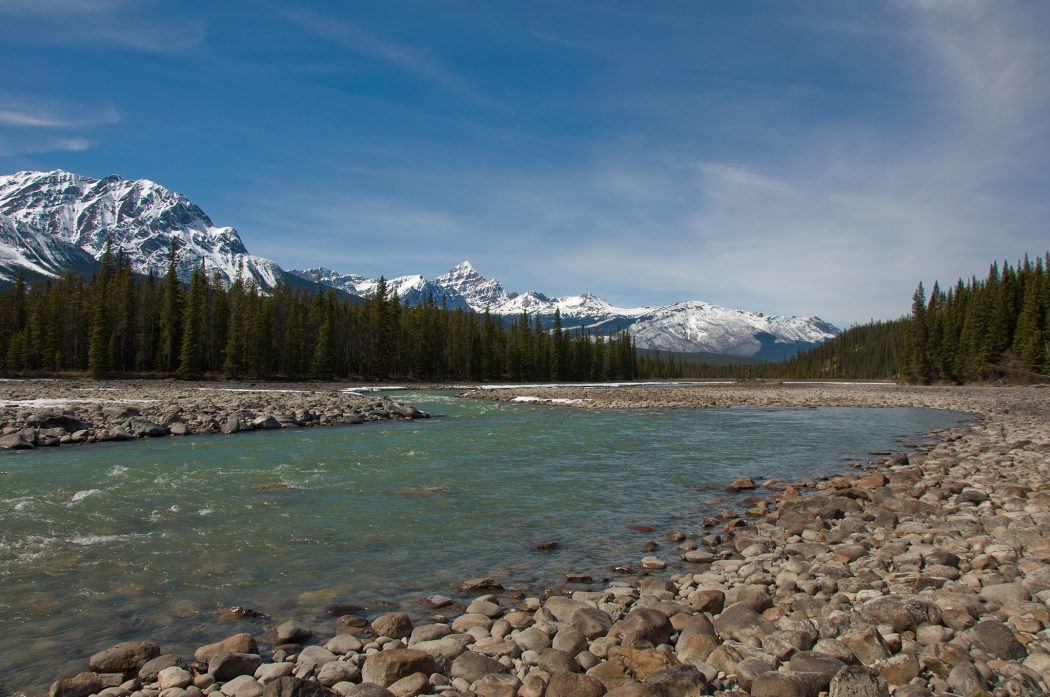
Canadian Rockies
UPDATED: This post, originally posted on July 1, 2017, has been updated on July 19, 2020.)
Canada is now 150 years old. We might be a young country, but as a destination, we have many offerings for tourists. With ten provinces and three territories extending from coast-to-coast-to-coast, covering a vast 9.98 million sq. kms, Canada is the world’s second-largest country by total area.
What you might not know is that Canada has many UNESCO World Heritage Sites. UNSCO – the United Nations Educational, Scientific and Cultural Organization – recognizes world heritage sites that are of significant cultural or natural value. And we have plenty of them. Here is a list – so time to pack your bags and hit the road and see these amazing sites:
Canada’s UNESCO World Heritage Sites
1. Canadian Rocky Mountain Parks, B.C. and Alberta: includes Banff, Jasper, Kootenay and Yoho national parks; and provincial parks Mount Robson, Mount Assiniboine and Hamber.
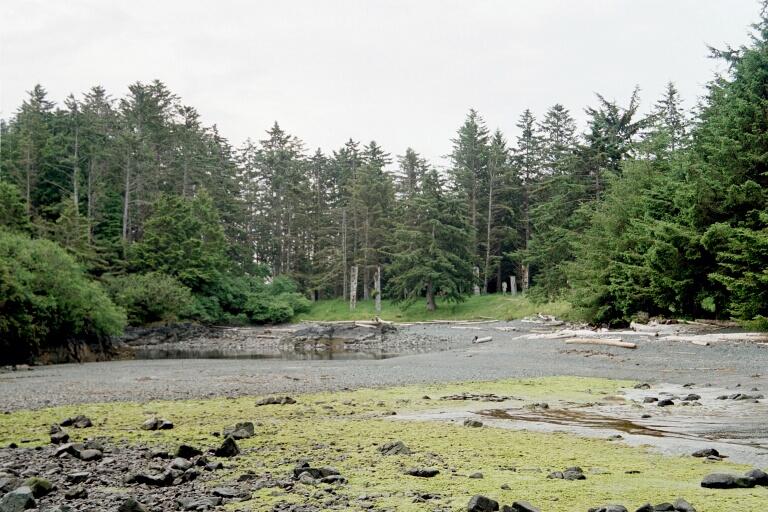
SGang Gwaay (credit: Grizzly01en)
2. SGang Gwaay, British Columbia: 19th-century Haida village.
3. Dinosaur Provincial Park, Alberta: located in the ‘badlands’ of Alberta where important fossils were discovered from the ‘Age of Reptiles,’ especially 35 species of dinosaur, dating back 75 million years.
4. Head-Smashed-In Buffalo Jump, Alberta: marked trails, an aboriginal camp and buffalo skeletons are what remain of a 6,000 year-old hunting custom.
5. Waterton Glacier International Peace Park, Alberta: the word’s first international peace park, with stunning scenery.
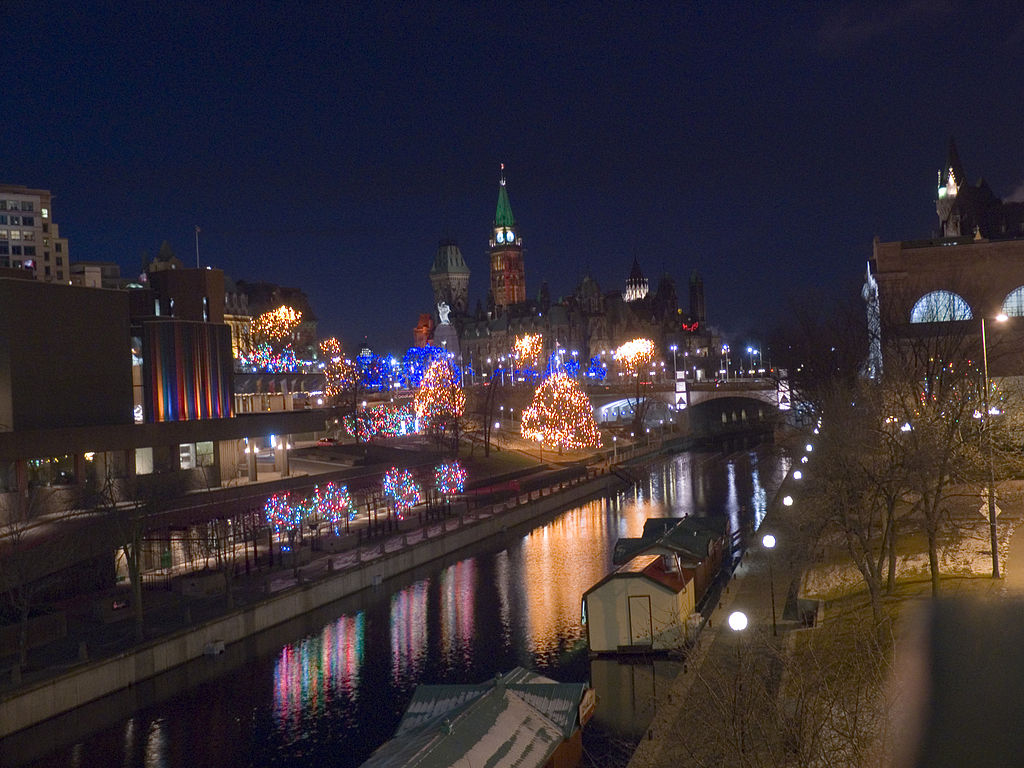
Rideau Canal (credit: John Talbot)
6. Rideau Canal, Ontario: a slackwater canal from Kingston to Ottawa, originally built for strategic military purposes.
7. Historic District of Old Québec, Quebec: a fortified colonial city founded in the early 17th century by French explorer, Champlain.
8. Miguasha National Park, Quebec: on the southern coast of the Gaspé peninsula.
9. Landscape of Grand Pré, Nova Scotia: marshland and archaeological site of the first European settlers in North America.
10. Old Town Lunenburg, Nova Scotia: British colonial settlement.
11. Joggins Fossil Cliffs, Nova Scotia: the “coal age Galápagos.”
12. L’Anse aux Meadows National Historic Site, Newfoundland: remains of an 11th-century Viking settlement.
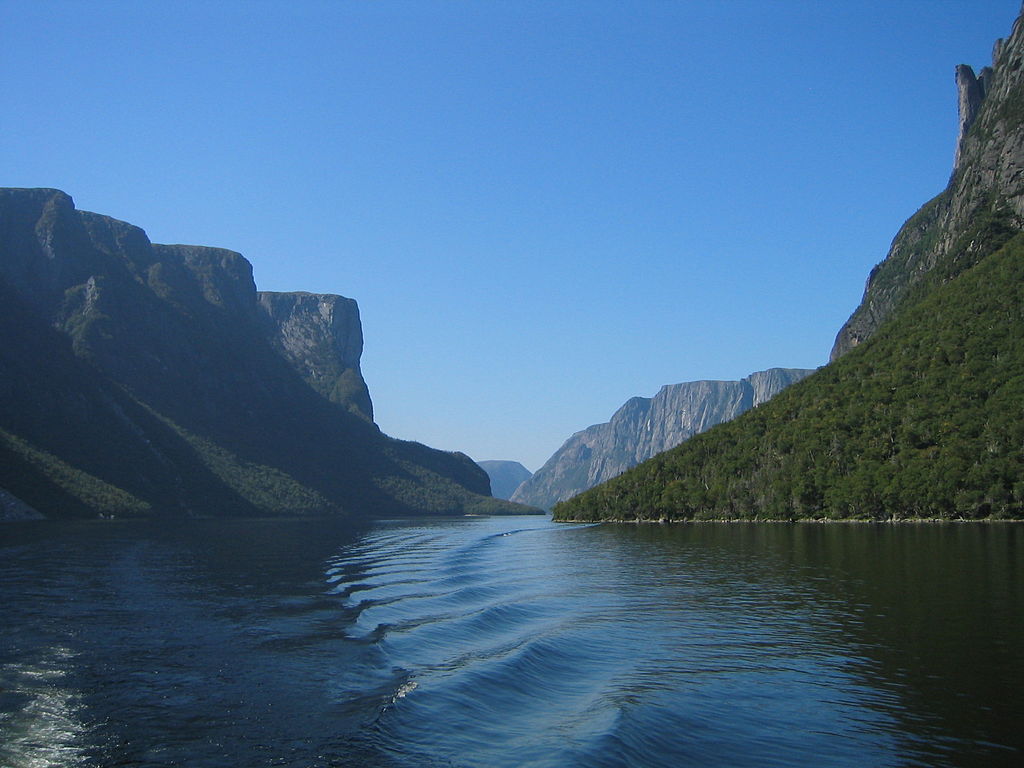
Gros Morne National Park (credit: jcmurphy)
13. Gros Morne National Park, Newfoundland and Labrador: spectacular scenery displaying some of the world’s best examples of the process of plate tectonics.
14. Red Bay Basque Whaling Station, Labrador: archaeological testimony of a pre-industrial whaling station.
15. Kluane/Wrangell-St. Elias/Glacier Bay/Tatshenshini-Alsek, Yukon Territory, BC (and Alaska): Spectacular parks, contains the largest non-polar icefield in the world.
16. Mistaken Point, Newfoundland: rugged coastal cliffs that stretch 17 kms.
17. Nahanni National Park, Northwest Territories: one of the most spectacular wild rivers in North America, plus deep canyons, waterfalls, and a limestone cave system.
18. Wood Buffalo National Park, Northwest Territories and Alberta: home to North America’s largest population of wild bison.
UPDATE (July 19, 2020):
On July 20, 2020, the Canadian Commission for UNESCO and the Canadian Geoparks Network announced that the Cliffs of Fundy, in Nova Scotia, and Discovery, in Newfoundland and Labrador, have been designated UNESCO Global Geoparks. Geoparks are sites recognized by UNESCO, the United Nations Educational, Scientific and Cultural Organisation, for their exceptional geological heritage. Being designated a Geopark means having the ability to mobilize local stakeholders to preserve unique geological sites and educate visitors about them. Geoparks also play a leading role in fostering high quality, sustainable tourism and contributing to the vitality of local economies (source: Canadian Commission for UNESCO news releease).
Canada. What’s not to love?
If you have visited any of these sites, I would love to hear what your favourite spot is. Tweet to me at @Shannon_Skinner or leave a comment below.
Love xo
Shannon
Shannon Skinner is an award-winning television and radio show host/producer, international speaker, author and travel writer. For more information, visit: ExtraordinaryWomenTV.com and ShannonSkinner.com. Tweet to her at @Shannon_Skinner.
++
Source: compiled from UNESCO World Heritage List.
Photo credit: Rockies – popejon2, Paddington, Australia (via Wikimedia Commons)
Visit these water sites to get your creative juices flowing
Water has a profound impact on us. The human body is mostly made of water, about 70 per cent, and we cannot survive more than than a few days without it. Coincidently, 70 per cent of the earth is covered with water. A large portion of the population lives on a waterfront. Tourists travel all over the earth to see or bathe in bodies of water.
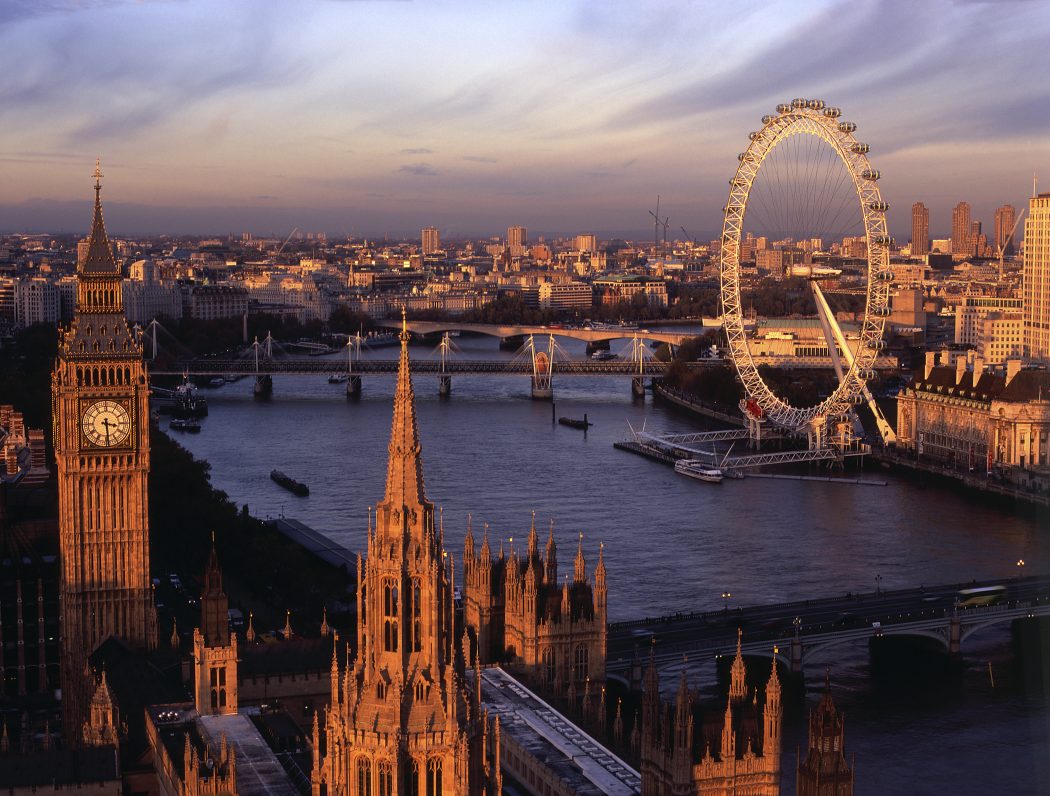
photo courtesy @VisitBritain
Water has many benefits. It impacts our mood. It is cathartic and healing. We meditate and reflect next to it. We play and exercise along beaches and shorelines. We sail and cruise on big bodies of water. There are sacred, holy rivers that appear in religious texts, and are used for rites of passage, such as baptism and spreading ashes after death.
Poets write about it; consider R.W. Emerson’s brilliant poem, Water. It is a recurring theme in literature (e.g.) Avalon. In mythology and folklore, holy wells or sacred springs are entrances to other worlds. The fantastical “Fountain of Youth” for centuries has had believers thinking we can stop the aging process – if only!
What’s more, water boosts our creativity and inspiration. When we are inspired and feel invigorated, we can unleash our creative genius. This is key to following our heart’s desires and having a fulfilling life.
As a traveller, I like to seek out places near magical water sites where I can recharge my energy and get inspired for my creative work. It especially helps me get out of a rut. I’m not a beach bum, though. Mostly, I like to walk near the water, and meditate and reflect as I go. This kind of meditate walk has been the most effective way for me to dig deep into my creative reservoir.
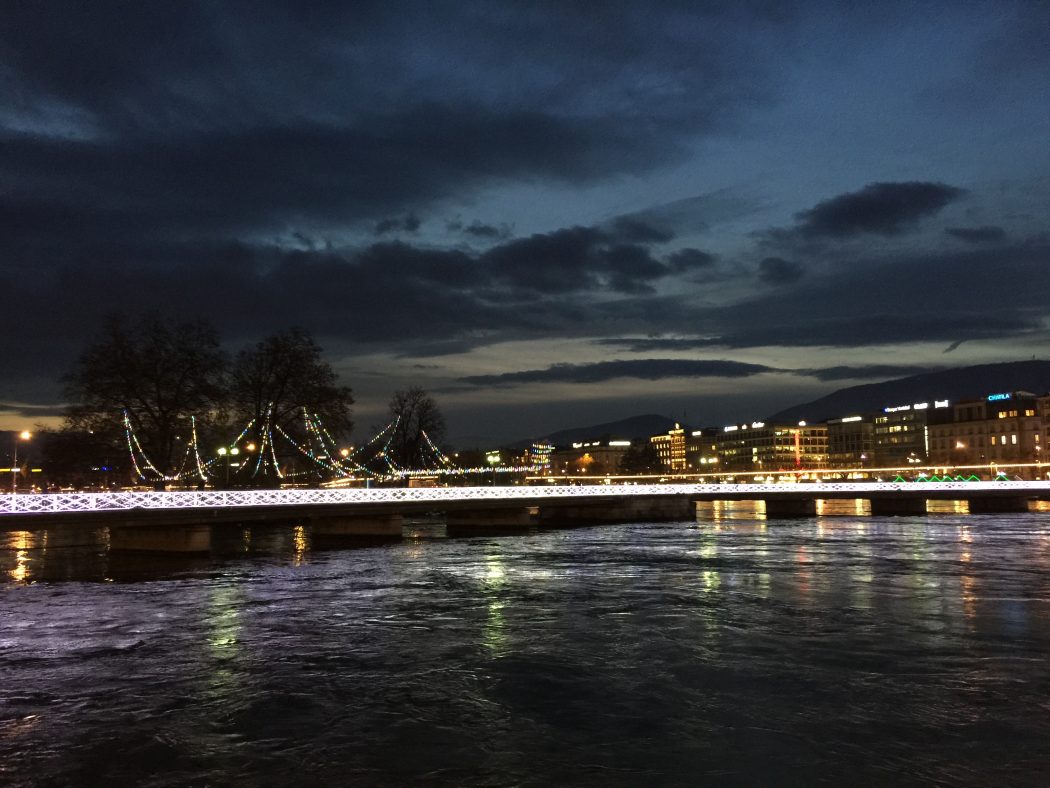
Lake Geneva in Geneva at early dawn
If you are in a rut or want to find your creative juices again, consider travelling to a place near water where many others have found inspiration, and tap into that energy. Here are some ideas:
- Ganges River, India: the sacred and holy Ganges River is India’s longest river and has great importance in Hinduism. Millions of Hindus come here annually to bathe in the water to wash away their sins, and be freed from the death-rebirth cycle. The sacred, historical city of Varanasi along the Ganges banks is impressive, and people visit from all over to practice yoga and visit temples that are centuries old. It has inspired many creative works.
- Lake Geneva, Switzerland: Geneva, Switzerland, the “capital of peace,” sits on Lake Geneva, which is snuggled in the Alps and shared between Switzerland and France, Lake Geneva has a long history of inspiring artists. Mary Shelley’s novel Frankenstein got its inspiration here. Deep Purple’s song “Smoke on the Water” was sparked when a hotel on the lake caught fire. Charlie Chaplin, Audrey Hepburn and David Bowie lived nearby, and today singer/songwriter Shania Twain owns a castle in the area. Geneva’s promenade offers a pleasant experience to stroll and meditate.
- River Thames, London: the longest river in the U.K., the banks of the Thames in London, particularly, has for centuries drawn many artists, has rich history and, of course, is popular for rowing. There is something magical about walking along London’s riverbanks, where one can soak in the amazing historical architecture. When I lived in London in the late ‘80s, every Sunday morning, my ritual was to walk along the banks to meditate and reflect – a time I treasure.
- Lake Ontario, Toronto: For those who either cannot or would rather not travel to get the creative inspiration that water offers, we have, of course, a fabulous lake in our own backyard. Best of all, it is free.
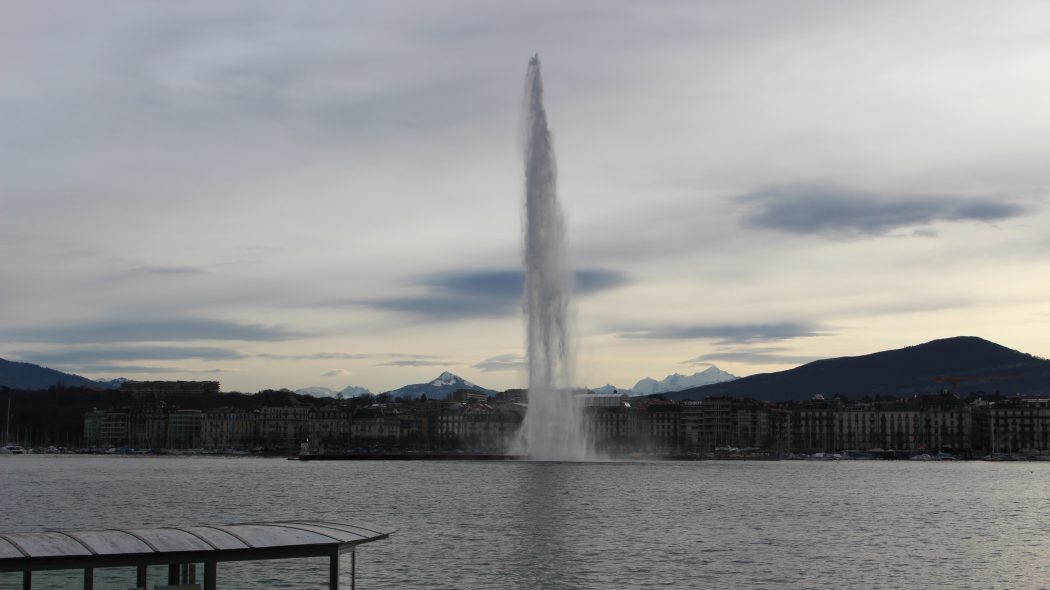
Lake Geneva harbour during the day
Shannon Skinner is a Toronto-based, award-winning television and radio show host, inspirational speaker, author, and occasionally writes travel articles. For information on her speaking engagements and interviews, visit: www.ShannonSkinner.com and www.ExtrarodinaryWomenTV.com. Tweet to her at @Shannon_Skinner.
Photo credit: River Thames courtesy @VisitBritain. Lake Geneva photos are courtesy my Canon.
This article was originally published in Toronto Waterfront Magazine (winter 2017)
10 tips for women travelling solo
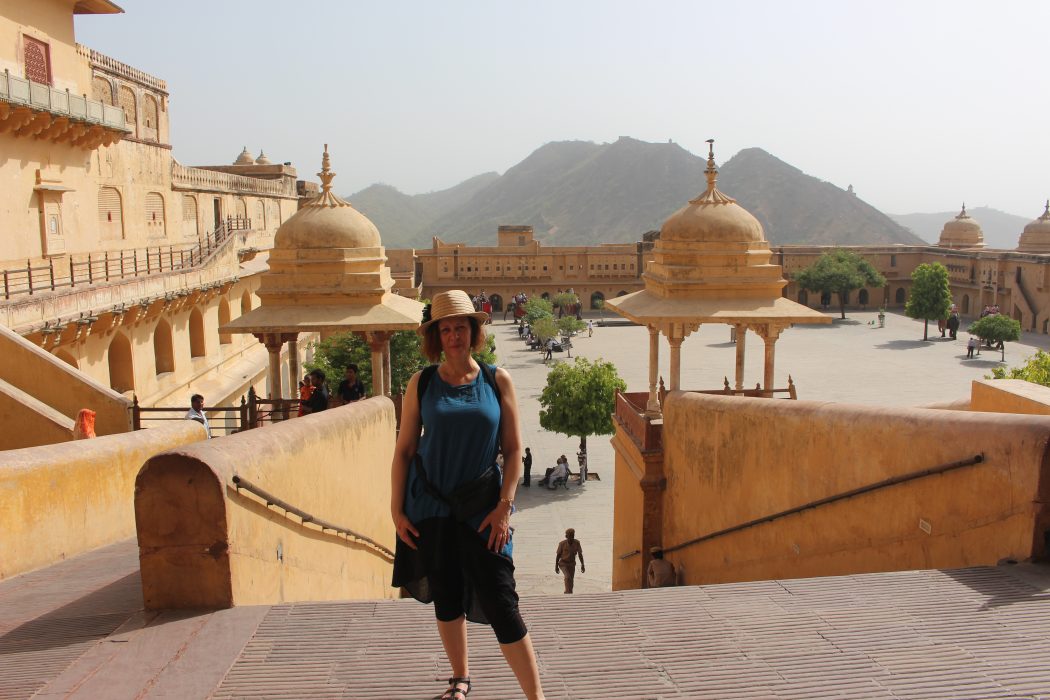
Jaipur, Rajasthan, India (2016)
Women travel for a variety of reasons, from recreation to business to study. For any woman travelling solo, personal safety must be paramount — regardless of the purpose. Whether you are travelling to a major city on business, taking the road less travelled, or doing the all-inclusive resort get-away, the same principle applies: put your safety first.
Here are 10 tips to help you enjoy your trip and stay safe:
1. Attitude Check: Do not be afraid to travel alone. Remember this: whatever we fear comes near. When planning your trip, closely examine your attitude about it. If you are experiencing fear about traveling solo, find the tools to quash it before you go. On the other hand, do not be cocky either. There is a fine line between being fearless and using common sense.
2. Research Before You Go: Every destination has its popular spots and areas where it may not be wise to venture into if you are a woman alone. Depending on your destination, culturally it may not be prudent for you to be seen alone at night, such as Morocco. In some major cities, if you turn the wrong corner you might find yourself in an area that makes you uncomfortable or unwelcomed, like New York or Johannesburg. The best thing to do is research before you leave to get an understanding of what you are getting yourself into and the areas to avoid.
3. Keep in Touch: Let your loved ones know where you are staying and also your travel itinerary. If you are accustomed to traveling alone, it might not feel like a “big girl” thing to do. But it cannot hurt and your loved ones will appreciate it. If you are going into countries where there is political unrest or conflict, check-in with Canadian embassy and stay up-to-date with travel alerts. Also be sure to leave a copy of your passport at home.
4. Emergency Plan: Have a plan for what you would do in the event of a medical emergency. Often this is the last thing on our minds when we are excited about upcoming trips. However, if you are traveling alone and become ill – or worse — it would be beneficial to know where you will find the best support and help locally. Also ensure your insurance is up-to-date before you leave.
5. Leave Jewels at Home: Leave your good jewelry at home where it is safe. Some single women wear a ring that looks like a wedding band to fend off unwanted attention. While I have tried this, I cannot vouch that it was effective. However, I have noticed that whenever I have worn good jewelry it has, at times, grabbed unwanted attention of locals trying to determine if I am a wealthy tourist.
6. Mind the Alcohol: If you are not fully aware of your surroundings at all times, you are highly vulnerable. I recall when I was in my twenties traveling through a European country with some girlfriends. One became extremely intoxicated and disappeared with a bartender for about an hour, until we – fortunately — found her on the floor behind the bar just as the guy started assaulting her. This does not mean be paranoid either; just watch the amount of alcohol you consume and do not accept a drink from a stranger.
7. Blend-in with Locals: Do not look make it obvious that you are a tourist otherwise you are making yourself an obvious target. Do not read maps in the open. Always look like you know what you are doing and where you are going. Be respectful of the local religious and cultural beliefs, even if you do not agree with them.
8. Carry Two Credit Cards: I like to take two credit cards, one as a back-up with plenty of room for purchases, in case something happens to my primary card. One of the drawbacks of traveling alone is that you do not have someone else you can count on if you run out of money, get robbed or if your credit card company freezes your card.
9. Trust Your Intuition: Listen to your gut instinct. If you are feeling somewhat unsettled or something feels “off,” pay attention to it. If you feel safe, you are safe.
10. Have a Pretend Boyfriend: Sometimes when I am asked by locals or other travellers if I am traveling alone, I say I am with or meeting my boyfriend — or husband. This is one of my “best practices” and really comes in handy, especially when sitting alone at a restaurant and a male waiter starts to probe. This might sound silly, but it works for me.
Shannon Skinner is the host/producer of ExtraordinaryWomenTV, a radio show host, international speaker and author, who lives to travel and discover fine wines. Tweet to her at @Shannon_Skinner.
This article was originally published in Infinity Magazine
Globetrotting with expert Dr. John Demartini: Travel Tips
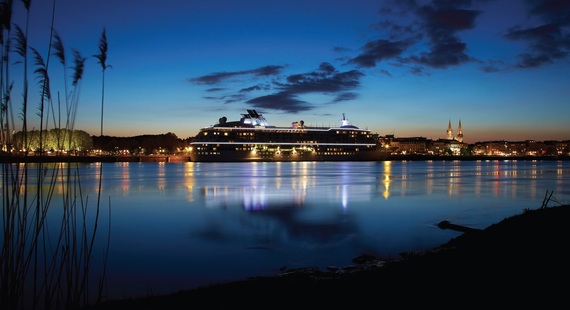
A renowned polymath, Demartini travels the world speaking, writing, researching and teaching. Every year, he travels to 45-60 countries, at an estimated annual cost of $500,000, and has logged a whopping 17 million miles. When not on the road, he lives on a ship, The World, a floating luxury condominium that visits 150-200 ports annually.
“My life is travel,” says Demartini, who was hijacked on a plane from Miami to Peru, has shared an aircraft with goats and chickens, and was mistaken to be a terrorist on a flight to Tel Aviv. “My existence is simple; I go from city to city.”
At age 21, Demartini had a vision of speaking to a million people from a balcony, and visiting every country and city. Now, at 62, he has spoken all over the world, including Greece’s Amphitheater. He is so travel-efficient that he can pack and unpack his bags, and organize his items in hotels, in 4 minutes.

JD: I have four bags, including one for my computer, gratitude journal and harmonica; a research bag containing 7-20 books and magazines; and two Tumi bags that have 6-8 suits, mix and match shirts and shoes, and accessories.
2. SS: How do you stay productive?
JD: When I am standing in line, I read. In club lounges, limos and airplanes, I pull out my computer or read. I don’t have much down time. I am able to produce wherever I am, except when checking in, or going through customs/immigration and security. I have no downtime at hotels with the exception of business meetings and dinners. I work into the wee hours of the morning.
3. SS: How do you eat healthily?
JD: I can usually find yogurt, fresh fruit and multi-grain bread in every country. Regardless of what is on the menu, I can usually get steamed veggies and fish, or soup.
On my ship, I can get whatever I want. On flights and in club lounges, I may not always get what I prefer, but can get healthy food.
4. SS: What do you do for exercise?
JD: While flying, I stretch, do neck rolls and exercises. At the hotel, I do light calisthenics like swimming or surfing. When I’m teaching workshops, I stretch and move my feet to keep my veins pumping to prevent deep vein thrombosis.
5. SS: How do you cope with jetlag?
JD: I don’t get jetlag as long as I rest. If I can’t sleep, I meditate because I can get by on meditation.
6. SS: What is your secret to living a global life?
JD: Ever since I was 21, I’ve said the affirmation: The Universe is my playground, the world is my home, every country is a room in the house, every city is a platform that I share my heart and soul. I envisioned an astronomical vision and a global life.
7. SS: Greatest challenge?
JD: When airlines overbook flights.
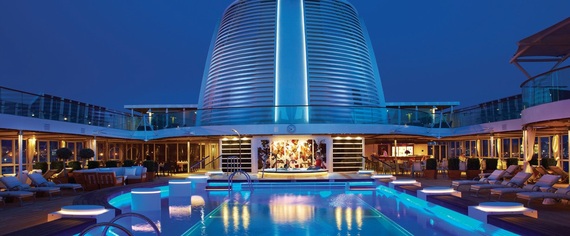
JD: I love being on my ship because it goes to every destination. I don’t know a better address on earth.
9. SS: Best advice for travelers?
JD: Think out your travel things and what is the most efficient way of doing it. Make sure you have a back-up of toiletries, underwear and shirts in case your bag is re-routed to the next city. And be mindful and carry a checklist at security to ensure you get your stuff.
For more information about Dr. John Demartini, visit: DrDemartini.com.
Shannon Skinner is a Toronto-based, award-winning television and radio host, inspirational speaker and author. For information on her speaking engagements and interviews, visit: www.ShannonSkinner.com and www.ExtrarodinaryWomenTV.com. Tweet to her at @Shannon_Skinner.
Photos courtesy of The World
Republished from Toronto Waterfront Magazine (www.waterfront-magazine.com), with permission.
Experience the life of a Maharaja in India’s “Pink City,” Jaipur
Rajasthan, the “land of the Maharaja,” is an exotic desert state in western India. It’s capital, Jaipur, is a historic walled city famous for enchanting “pink” fortresses and palaces, and royal dynasties. Here in the “Pink City,” I got a taste of the opulent lifestyle of the Maharaja, the once powerful rulers of Rajasthan, by staying in a royal family home.
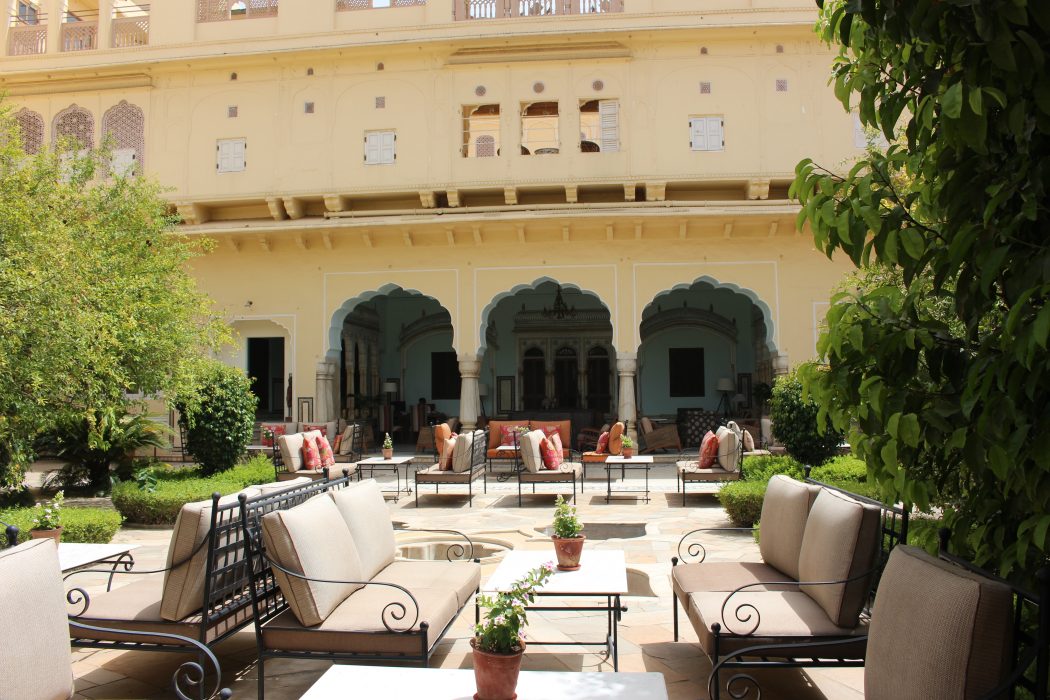
“Rajasthan has many small boutique hotels that were the residences of noble families,” said Vikas Abbott, managing director, Vasco Travel, India’s largest family-run, inbound travel company. “Now they’ve converted them into nice heritage hotels. It’s really a different experience and these hotels give you that character of India.”
Jaipur was founded in 1727 by Maharaja Sawai Jai Singh II, when this area of India comprised Princely states. Men wore silk robes, jewels and colourful turbans (some continue the tradition); and women wore elegant sarees. It’s a place I have always been draw to.

This May, I traveled to Jaipur after speaking at the Women’s Economic Forum in Delhi, for some creative inspiration. In the midst of the desert, despite a heat wave (47C), I found an urban oasis: the Samode Haveli (“palace”), a heritage luxury hotel built nearly two centuries ago as the residence for the rulers of Samode, Rajasthan. Today, it is owned by Mr. Raghvendra Singh and his brother, descendants of the rulers, who inherited the royal residence.
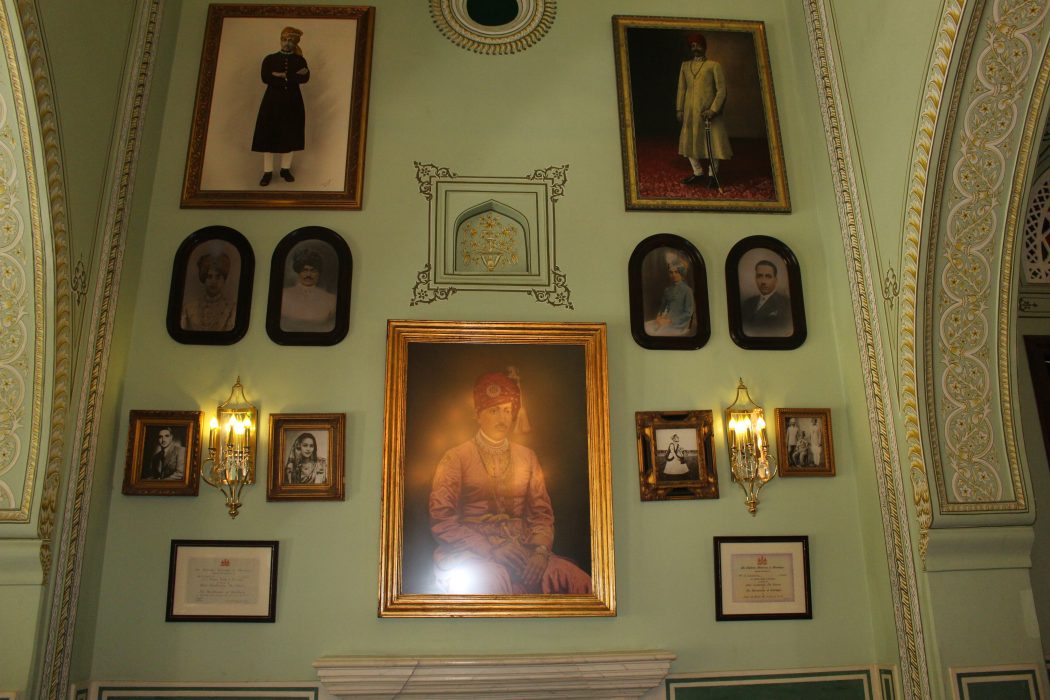
Faced with the challenges that come with inheriting a royal residence, such as finances and maintenance, in the ‘80s, the Singhs decided to convert their property into a luxury boutique hotel. “I had a vision and it turned out to be good for us,” says Mr. Singh, a distinguished and modern businessman. The Singhs were ahead of their time, when many other families who inherited royal residences also faced similar challenges.
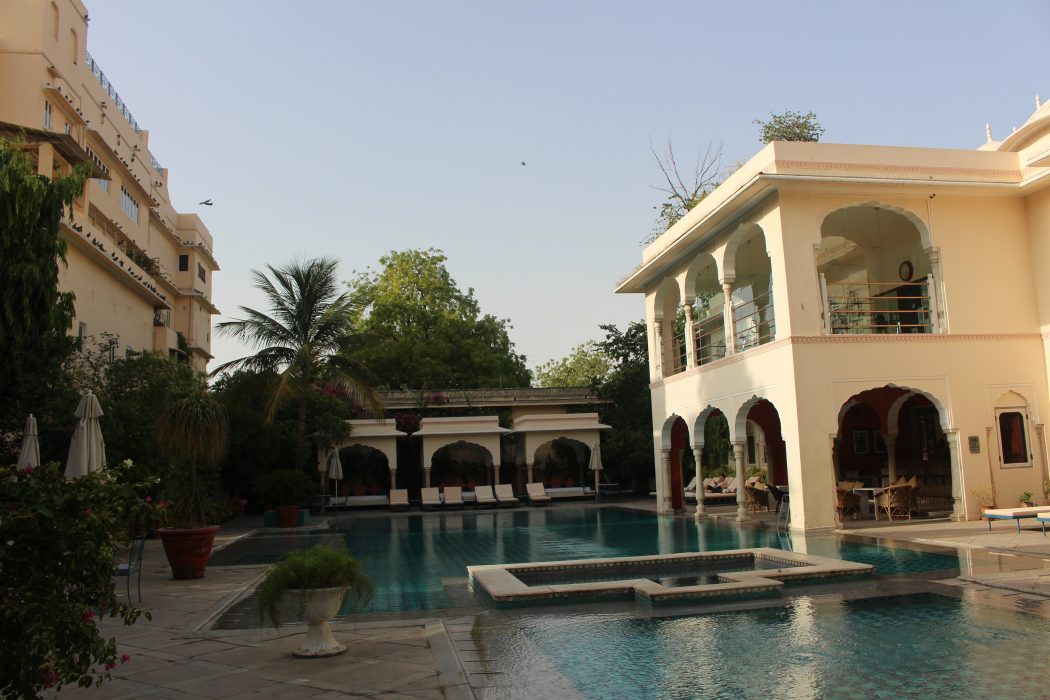
The royal apartments were turned into deluxe rooms and suites, and each has a unique and distinctive character, while maintaining contemporary amenities to meet the needs of the modern-day traveler. The rooms are situated around courtyards, gardens and a stunning swimming pool. There is even a modern spa and fitness area. Meals are served in opulent rooms with chandeliers and paintings of the family’s Maharaja ancestors (note: I must say my favourite meal was stuffed tandoori bell peppers with potato and dried fruit and cheese).
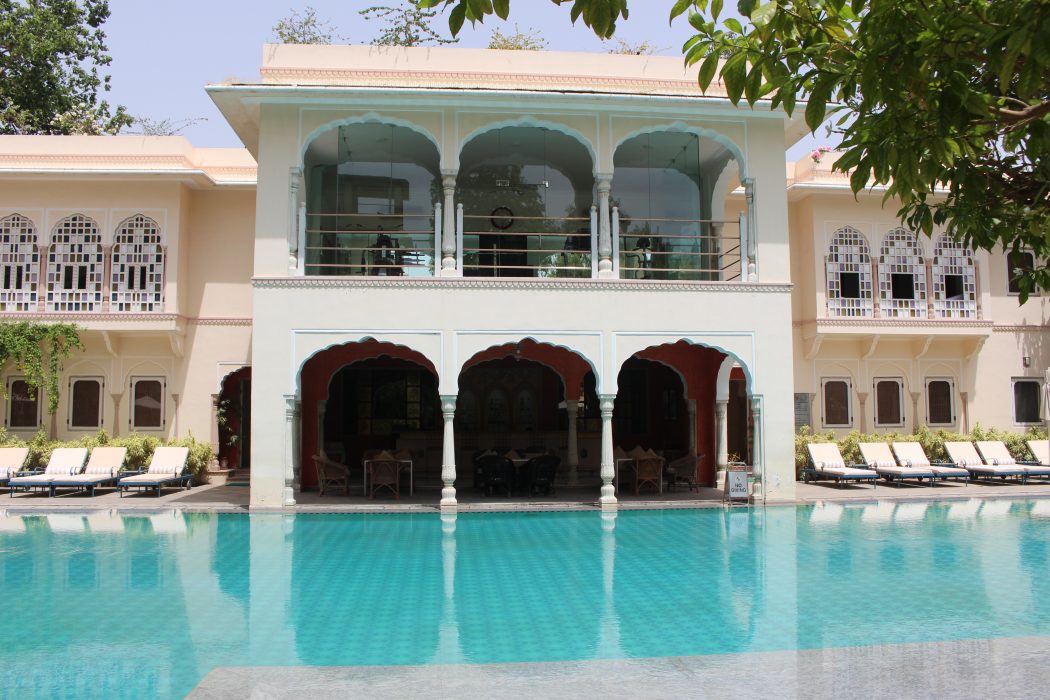
The Singh family (Raghvendra, his wife and two children) resides in a private residence in the complex; and expansion plans are underway for 50 more rooms.
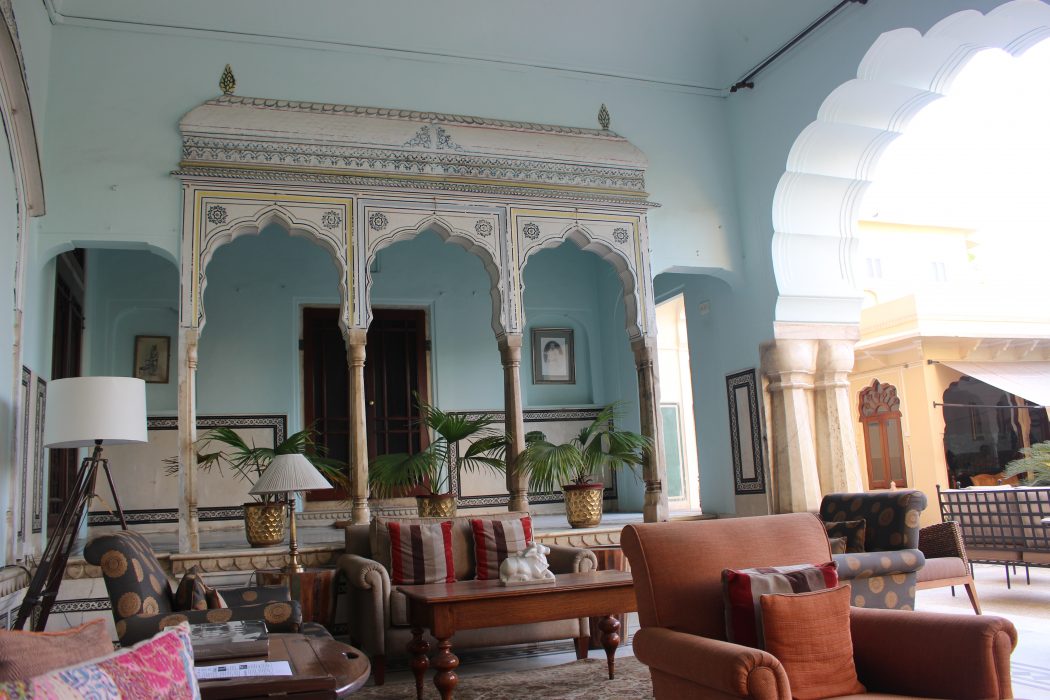
It was like staying in a palace and I felt like a queen.
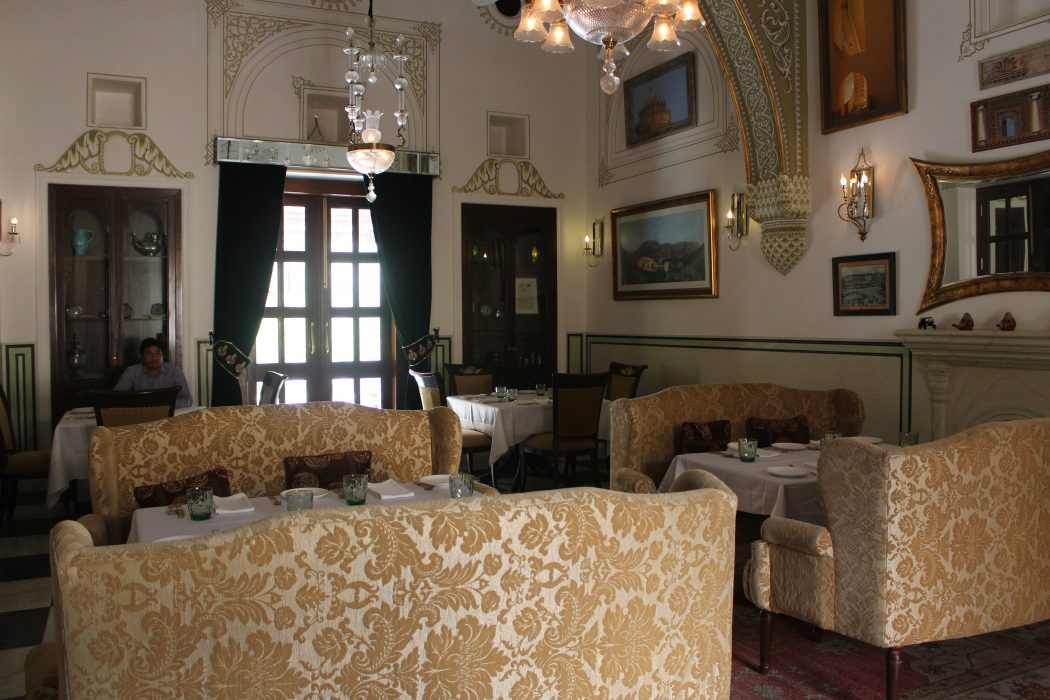
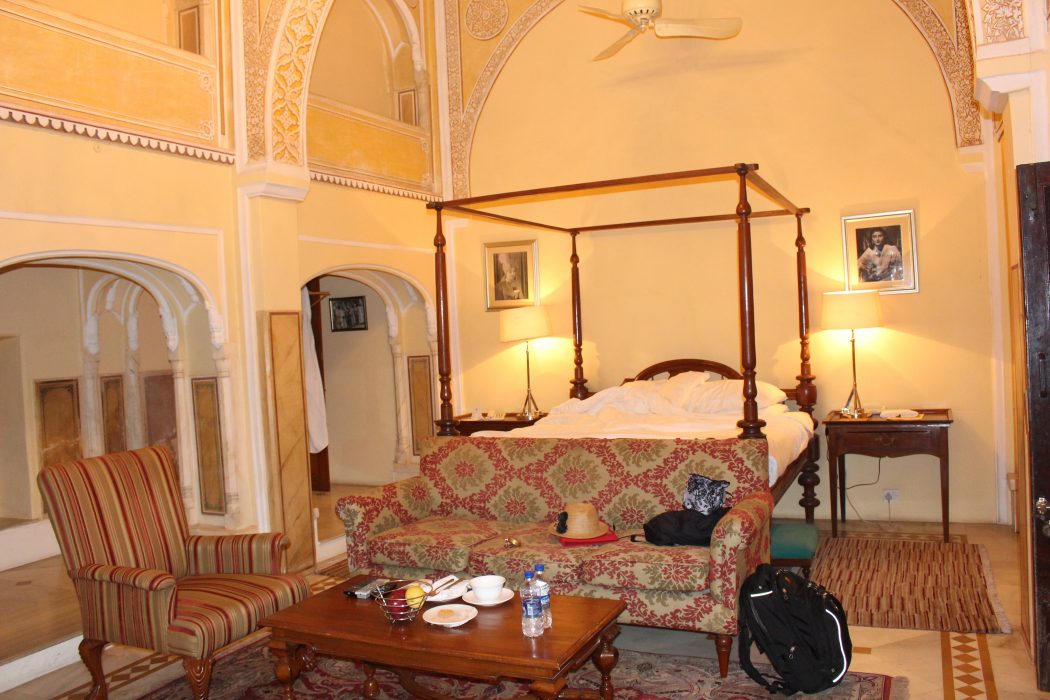
In addition to staying in a royal home, there are many sites in Jaipur to visit to get a taste of the life of the Maharaja:
1. Amber Fort: A popular attraction at this UNESCO World Heritage Site is to ride an elephant to the gate. Located 12 km north of Jaipur in the town of Amer, Amber Fort (aka Amer), is a 16th century architectural marvel made of red sandstone and marble. Its Palace of Mirrors has beautiful mirrored ceilings; and there are several courtyards and “apartments” for each of the royal women (the king had 12 queens), and a lovely garden and temple.
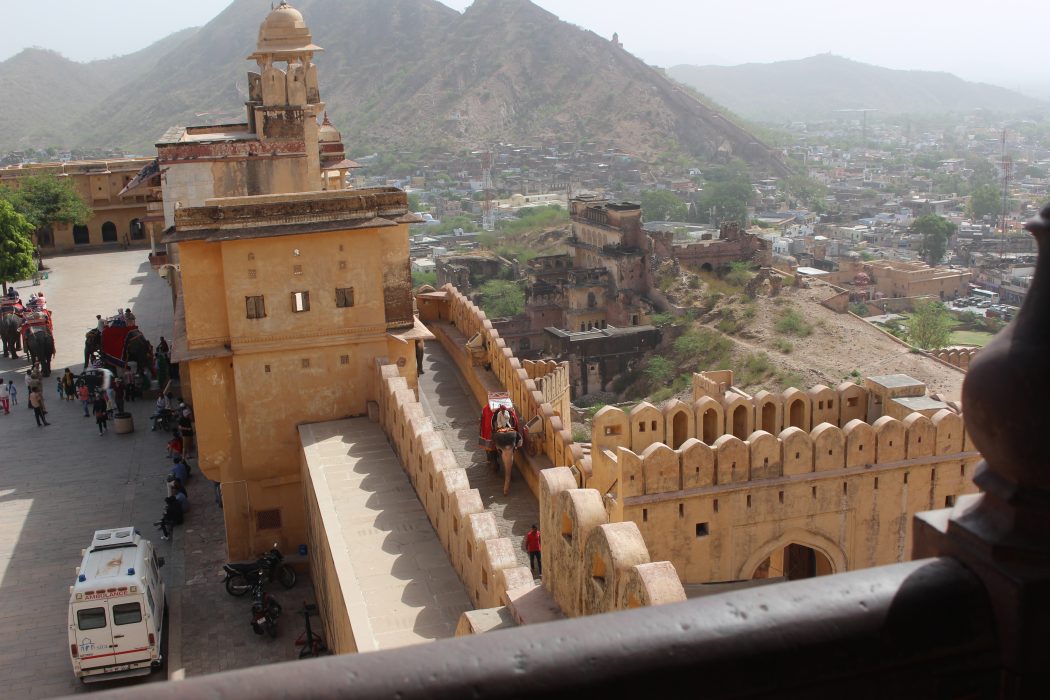
Underground tunnels connect to nearby Jaigarh Fort, part of the same complex, that was built as a military fort to protect Amber Fort and palace. Renowned for the world’s largest cannon on wheels and an intriguing story of hidden treasure.
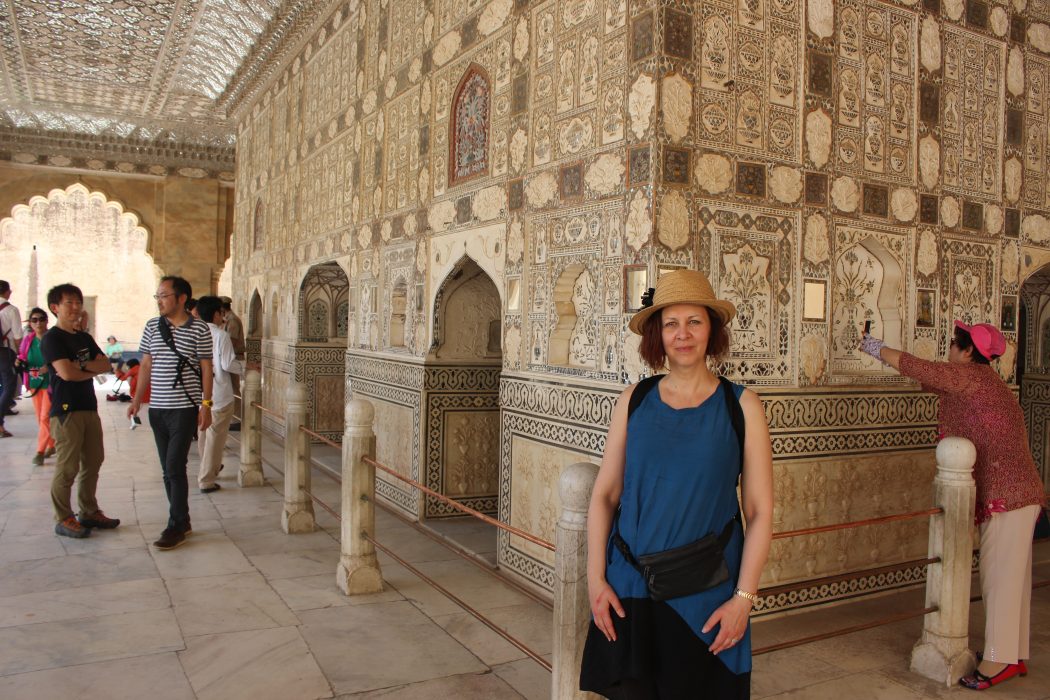
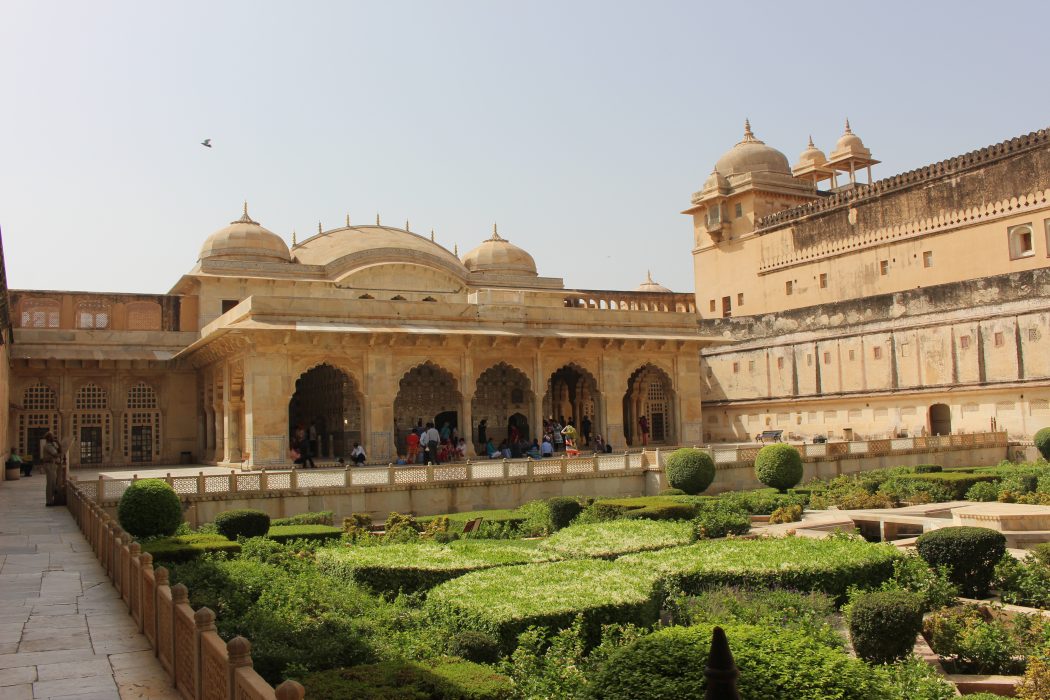
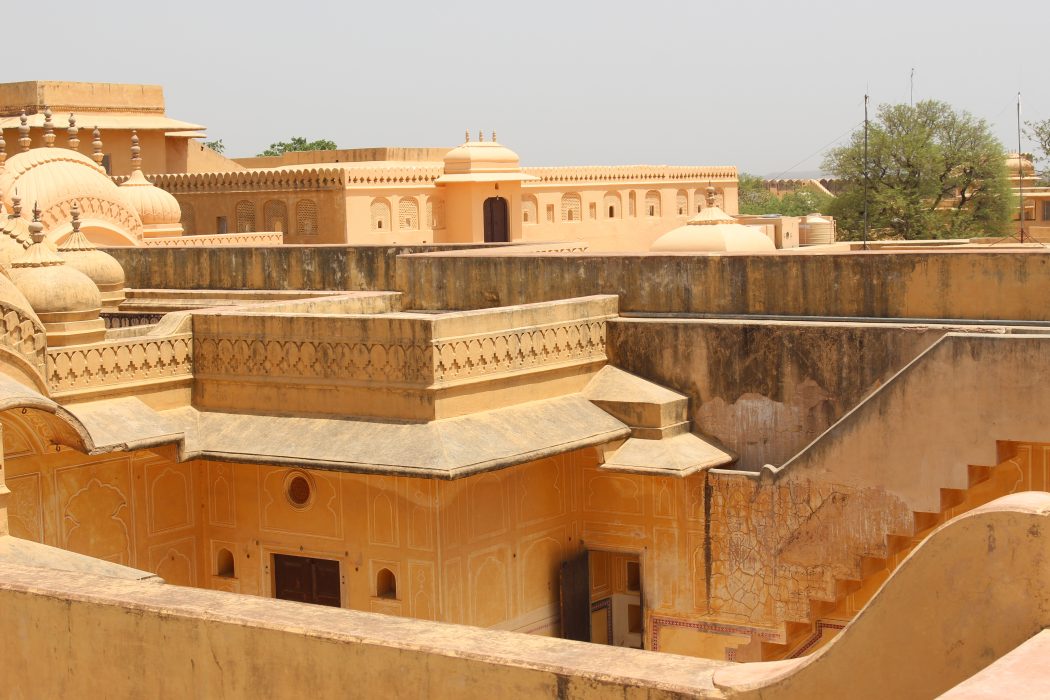
2. Naharghar Fort: the “abode of the tigers” was built at the edge of the Aravalli Hills, and offers a must-see view overlooking the Pink City.
3. Hawa Mahal “Palace of Winds:” a 5-storey façade built for royal women to watch processions and street festivals below through windows covered with lattice, as they had to be hidden from sight.
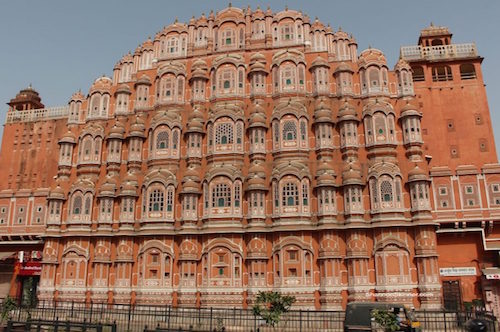
4. Maharaja’s City Palace: a former royal residence that is now part museum with a small portion used by Jaipur’s current royal family. The museum has a variety of weapons, textiles, and clothing of past kings. In the courtyard, music students attend flute lessons.
5. Jantar Mantar astronomical observatory: this UNESCO world heritage site is one of the largest stone and marble-crafted astronomical observatories in the world, built 1728-1734 by Maharajah Sawaii Jai Singh II.
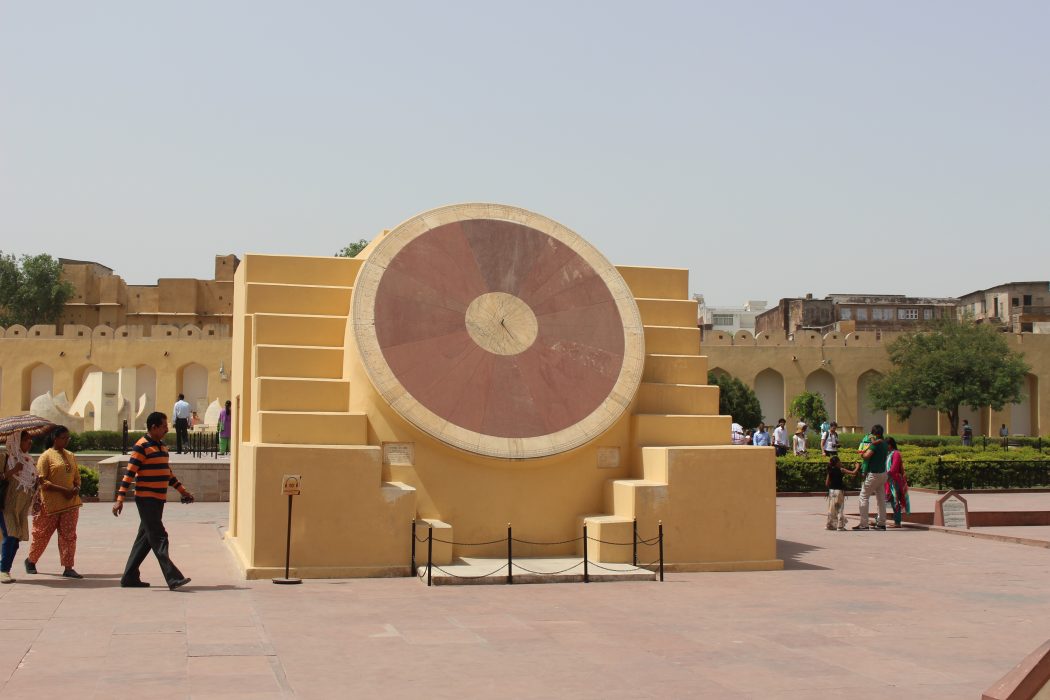
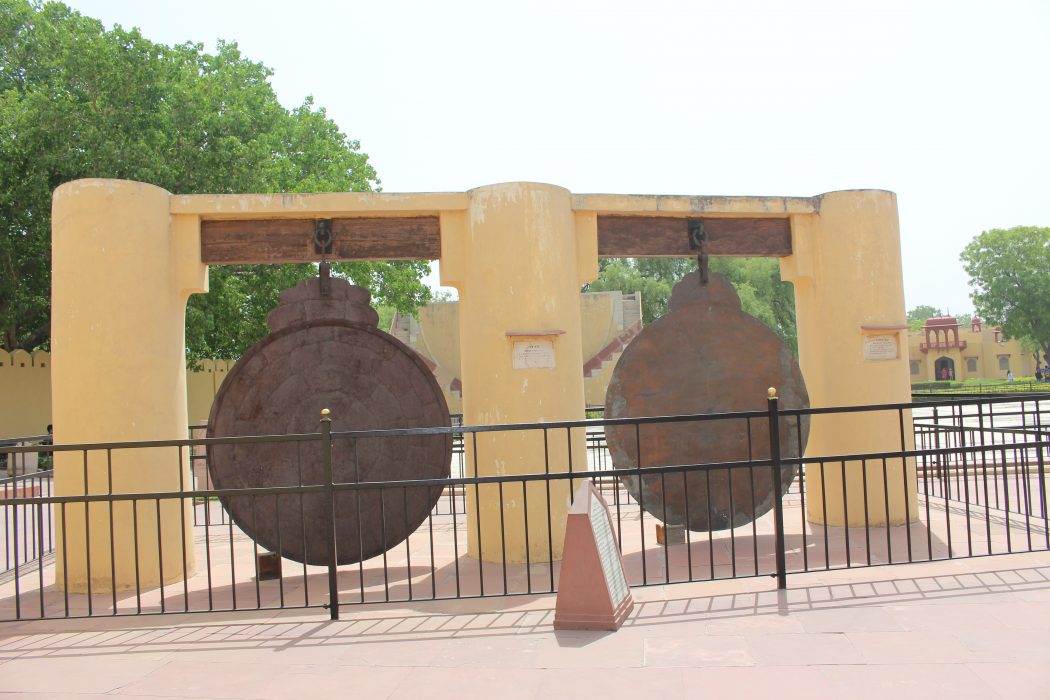
6. Galta Monkey Temple: a newer temple built on ancient land that looks like a palace, honours the Hindu Monkey God. Many monkeys dwell here. Local Hindus come to swim in the water that flows from the mountains, and it provides tranquility from the city.
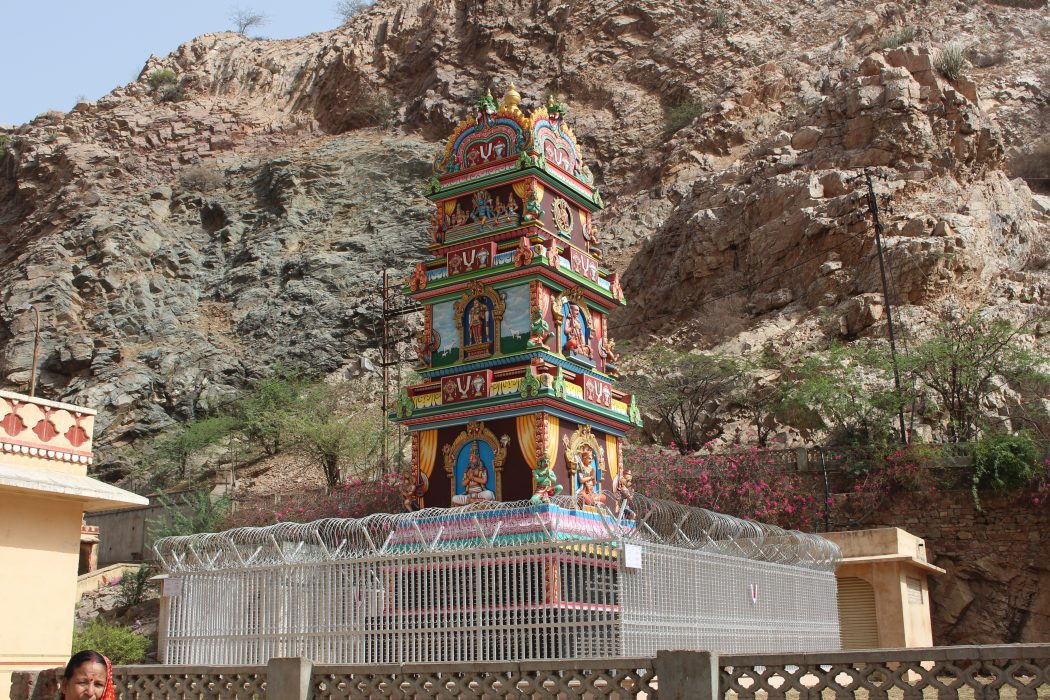
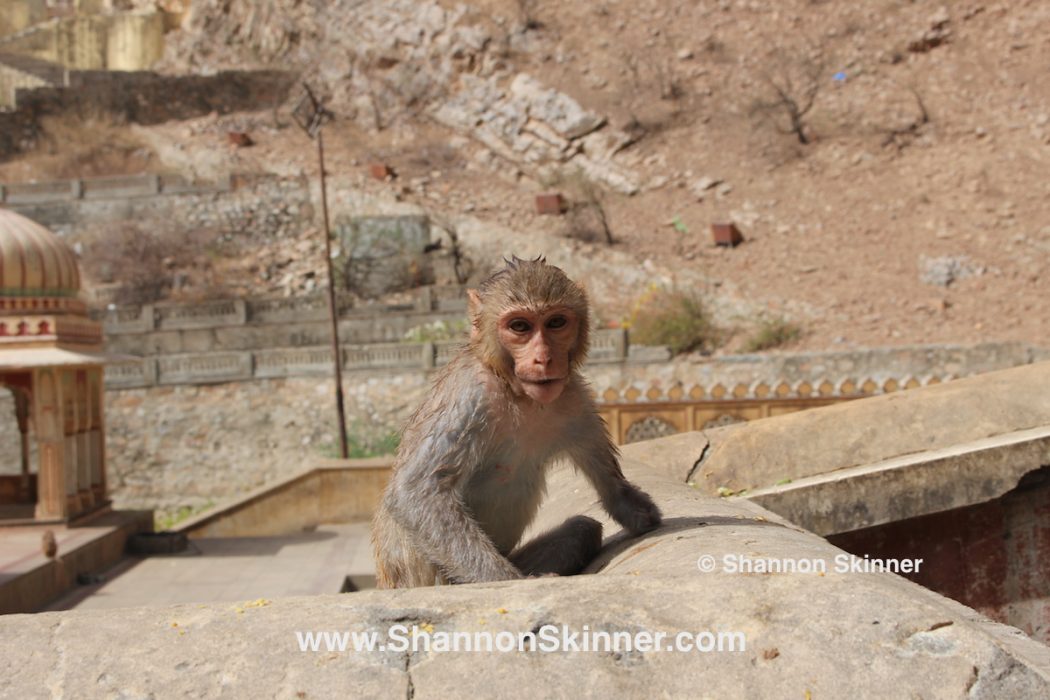 Accommodations provided courtesy of Samode Haveli; arrangements for land transportation and guide provided by Vasco Travel.
Accommodations provided courtesy of Samode Haveli; arrangements for land transportation and guide provided by Vasco Travel.
Shannon Skinner is a television and radio host, speaker and author, and occasionally writes travel articles at http://www.ShannonSkinner.com.
India’s Incredible Living Root Bridges
 SHANNON’S TRAVEL BAG: Travel Tips for Women
SHANNON’S TRAVEL BAG: Travel Tips for Women
Shannon travels to India. This is part 4 in a series of articles.
India’s northeastern state of Meghalaya (meaning “Abode of the Clouds” in Sanskrit), is breathtaking with its tropical forests and lush green mountains – and fluffy, white clouds. Unique to this wet and remote area are spectacular living root bridges.
(Abode of the Clouds)
Invented by the indigenous Khasi tribe, who live deep in the misty jungle, these “bioengineered” suspension bridges are made by shaping the living roots of rubber trees that are native to India’s northeast — a process that takes many years. Unlike modern concrete, metal or wooden bridges, these living root bridges are alive and continue to grow and get stronger over time. They can be as long as 100 feet and their roots are extraordinarily sturdy. Not one nail is used. It takes about two decades for the bridges to be useable and they can hold up to 50 people.
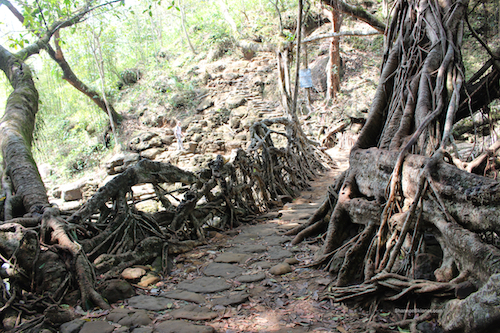
(living root bridge near Mawlynnong village…all photos on this page are the same bridge)
The bridges are necessary for the villagers because the region is filled with rivers and streams, and heavy monsoon rains tend to destroy bridges made of bamboo. The Khasis would become stranded – and so they got inventive (the area is also home to the Jaintias and Garos tribes).
Most of Meghalaya’s many living root bridges are located near Cherrapunjee (also known as Sohra), a small town located on the edge of the East Khasi Hills, about 60 kms from the capital, Shillong, and is regarded as the rainiest place on earth. It is a destination for waterfalls, cave exploring, hiking and treks to the living root bridges.
The most famous of all bridges is a 2-level “double decker,” estimated to be two centuries old. It was discovered by Denis Rayen, a former banker who, along with his wife, Carmela, founded the nearby Cherrapunjee Holiday Resort, and who I had the pleasure of having a cup of tea with after touring a living root bridge. Rayen is extraordinarily passionate about the Cherrapunjee area and is credited with putting the living root bridges on the map as tourist sights, which has also been the subject of BBC and Japanese TV documentaries.
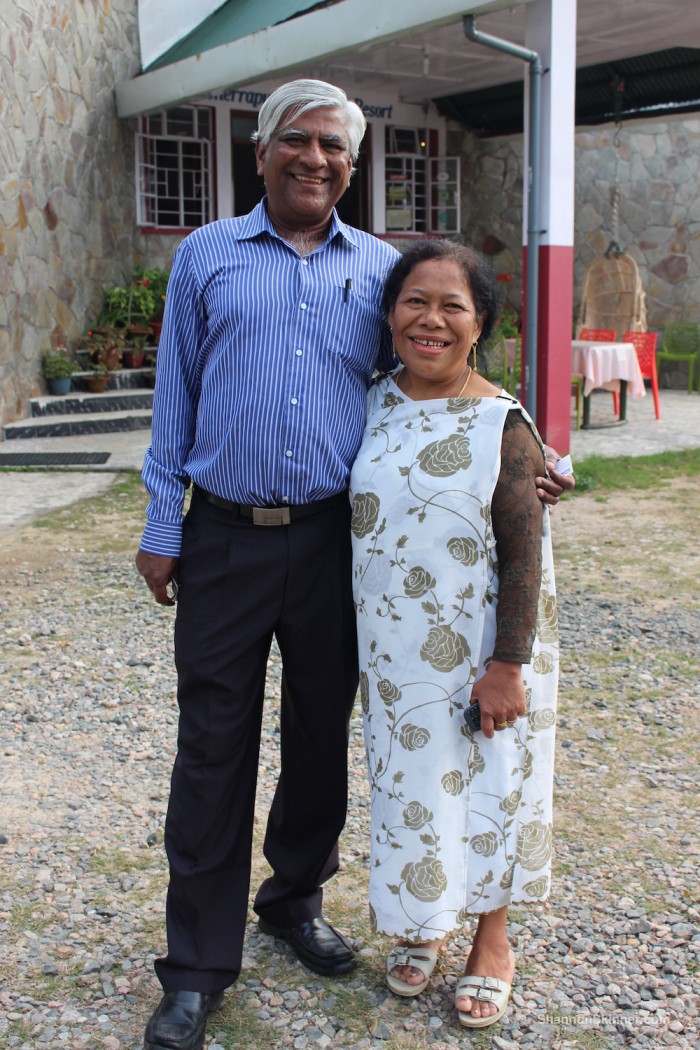 (Denis Rayen and Carmela at their Cherrapunjee Holiday Resort)
(Denis Rayen and Carmela at their Cherrapunjee Holiday Resort)
Rayen explains to me that these durable bridges can last several centuries and have been made for the benefit of the tribe’s future generations. “It’s not done for your lifetime, it’s done for future generations,” says Rayen. “Once made, they have a lifetime of about 400 to 600 years, so that’s quite a few generations that can use it.”
In fact, the locals are said to be adding a third level on the double-decker, to draw more tourists.
Many of the living root bridges require a long, challenging trek to access them. The one I had the opportunity to see, which is one of the most accessible, is near Mawlynnong village, 90 km from Cherrapunjee (and 100 km from Shillong). Mawlynnong is dubbed as the “cleanest village in Asia,” known for its paved walkways, beautiful flowerbeds, waterfalls and its beautiful trek to the living root bridge.
And what a sight to behold!
After about a 10 mins walk down cement steps and rocks leading down to the valley’s lower reaches to a stream, standing before me was a messy tangle of roots of a living bridge. It looked like something out of a sci-fi movie.

Any hesitation was put to rest when a group of local children skipped down the steps in flip-flops without hesitation because, of course, it is second nature to them. The boys climbed the bridge’s tree trunk and then stripped down to their undies for a swim in the stream. The girls, all immaculately dressed in school uniforms, sat on rocks as they chatted and ate packed lunches. I sat on rocks from a distance, in peace and tranquility, observing the children enjoying themselves in their daily lives. As the stream glistened against the backdrop of the living root bridge and lush greenery, I had gratitude not only for a once-in-a-lifetime “National Geographic” moment, but also for the awe-inspired, human-made natural wonder before my eyes.
(local Khasi boy contemplates going for a swim, which he does)
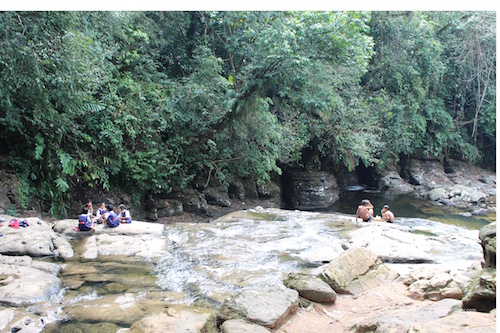
(Khasi children sitting on rocks near bridge having their lunches after boys go for a swim)
My guides, transportation and accommodations while in India were provided by Vasco Travel, whose team worked tirelessly on perfecting every detail, even checking in with me daily.
To get there: my route once in India was Delhi-Guwahati, Assam by air (via Air India); and then by car to Shillong, Meghalaya, which we used as a base for day-trips to Cherrapunjee and Mawlynnong. Best way to see the region is by car.
Resources: India Tourism and Meghalaya Tourism; and Vasco Travel, industry leaders in travel to India, based in Delhi. In Canada, Vasco is represented by Canadian Travel Services.
Shannon Skinner is a television host, inspirational speaker and writer. You can read her travel articles at Shannon’s Travel Bag.
In Pictures: Rongali Bihu Festival in Assam, India
 SHANNON’S TRAVEL BAG: travel tips for women
SHANNON’S TRAVEL BAG: travel tips for women
Shannon travels to India. This is part 3 in a series of articles.
In Pictures: Rongali Bihu Festival in Assam, India
I’ve just returned from an amazing 2-week trip to India. As I wrote in my previous post, the first stop on my journey was attending the Rongali Bihu Festival in Assam, the north-eastern state in India that is located south of the eastern Himalayas – and where “Assam tea” comes from. Rongali, meaning “colours,” is a special celebration of the Assamese New Year and coming of spring, with the hopes of peace and prosperity. Rongali is one of three Bihu festivals that take place throughout the year, with Rongali being the biggest in Assam.
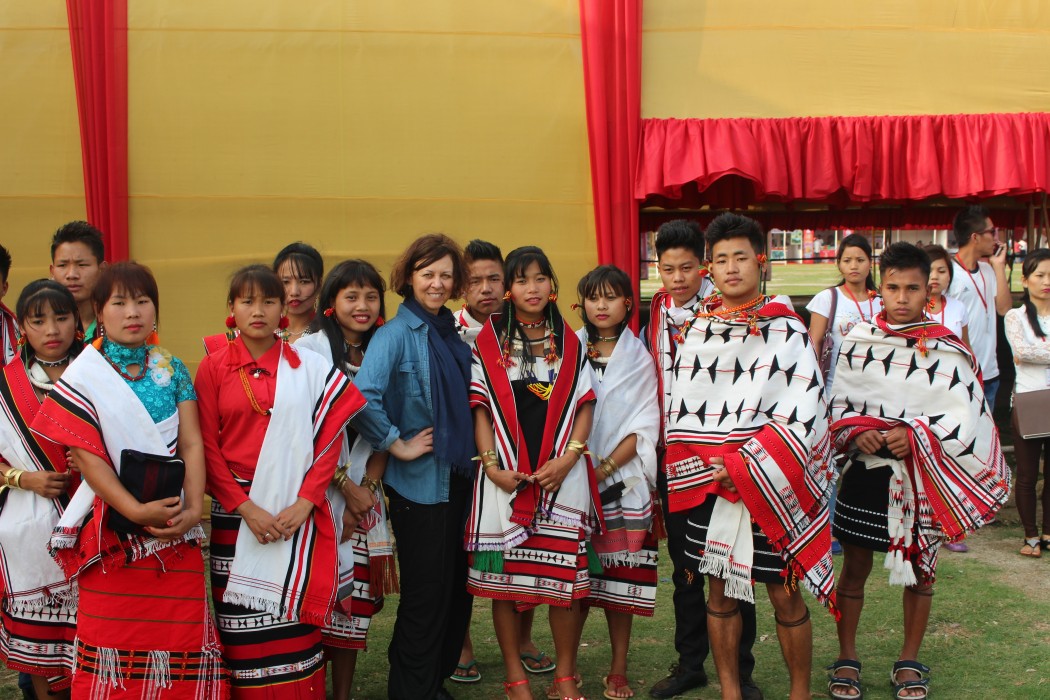
On April 3-5th, 2015, the community in Guwahati, Assam, held a multifaceted Bihu festival highlighting the arts and culture of the Assamese communities and tribes. This included folk dance, rock and Bollywood music (including Bollywood star, Papon), handicrafts, fashion, traditional sports and oh-so-yummy food.
Assam, the gateway to the northeast, is unexplored – and more than ready for tourism. The festival was designed as a much-needed tourist draw that, under one platform, features the essence of Assam, a state which boasts a number of wildlife sanctuaries, the Brahamaputra River, is home to the one-horned rhino and Royal Bengal Tiger, and is large tea-growing region. “This is a springtime Bihu where there are a lot of festivities, and people are singing and dancing, and making merry,” says Rongali Festival organizer, Shyamkanu Mahanta.” This is a typical way of focusing on our own culture to promote tourism.”
Here are some highlights:
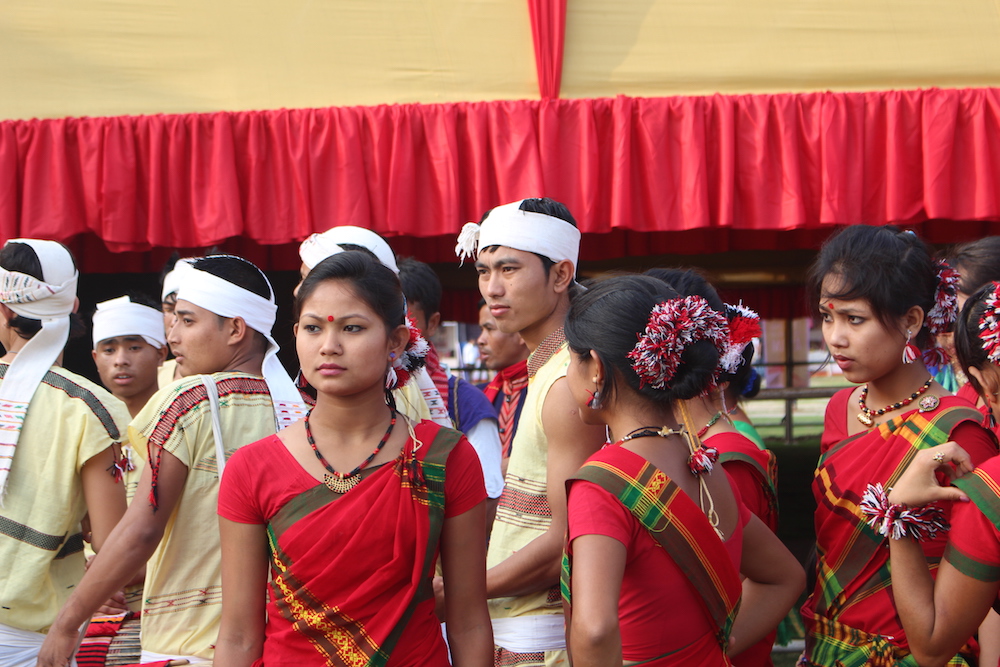
Several Assam tribes prepare to perform Bihu dances in competition (50+ dance forms)

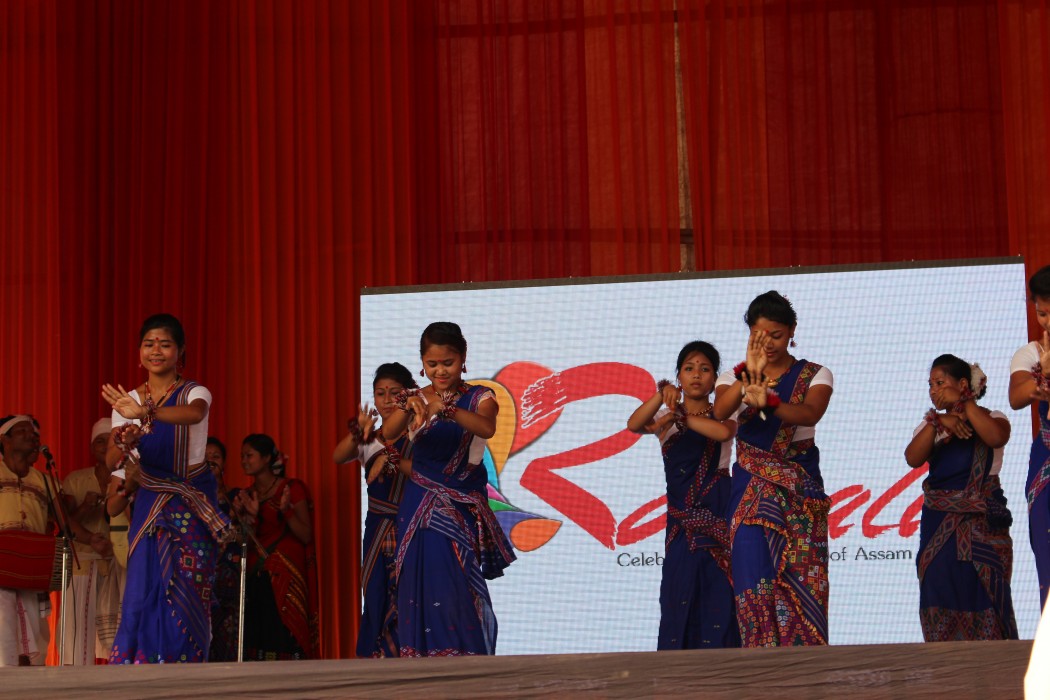
On stage…all dance groups had their own distinct costume and dance form. Truly amazing.
Festival organizer, Shyamkanu Mahanta, and emcee, a famous Assam actress/dancer, Barasha Rani Bishaya.
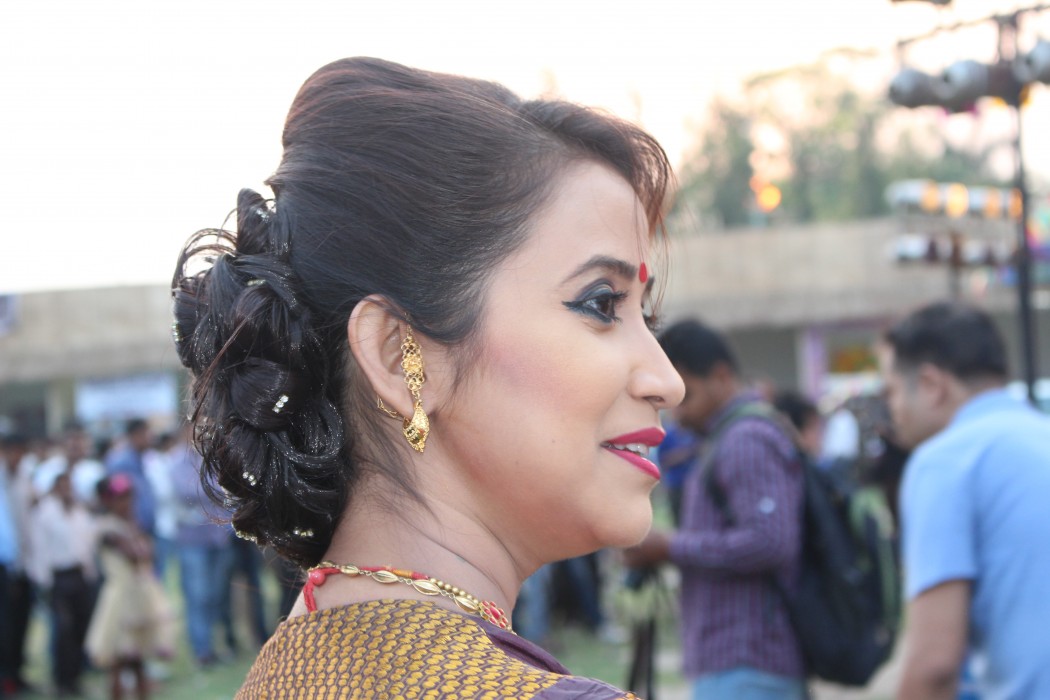 A closer glimpse of the lovely star emcee, Barasha Rani Bishaya.
A closer glimpse of the lovely star emcee, Barasha Rani Bishaya.
Dignitaries in attendance, including Tourism Minister of Assam, Ms. Sumitra Patir (seated in the lovely traditional Assamese sari)
Then this happened…I was interviewed by “DD News” TV Delhi. I was also in a number of Indian newspapers – read more about it). The traditional dress I am wearing actually came with me from Toronto!
And there was a thrilling dance drama performance of the classic tale, Kaliya Daman, in the famous form called Ankia Bhaona, which has been performed in India for 500 years. All actors are male, including female roles.
Fashion show of saris by a local Assam designer Mehzabin Ershad. Loved this!
Designer Mehzabin Ershad reacts to the roaring cheers of the crowd.
Famous Assam singer, Manas Robin, one of several artists who performed; with a former TV journalist attending.
 Manas Robin rocked the house. I really enjoyed his music.
Manas Robin rocked the house. I really enjoyed his music.
My new travel friend, Tom Peters, former editor of a major Canadian newspaper. I had pitched him many news stories over the years, though never met him until the flight from London to Delhi (lesson: never burn bridges!)
Some of the vendors… above is an exhibition on how silk is created from worms.
To my surprise, I became somewhat of a celebrity, with locals wanting to take photos with me.
Assam is known for its silk.
“Gamochas” Assamese traditional hand towel and fabric.
This girl is donning traditional Assamese fabric.
Smoking meat, fish, veggies the Assamese way.
Drummers from the Meishing Tribe.
Yeah, I’m a groupie.
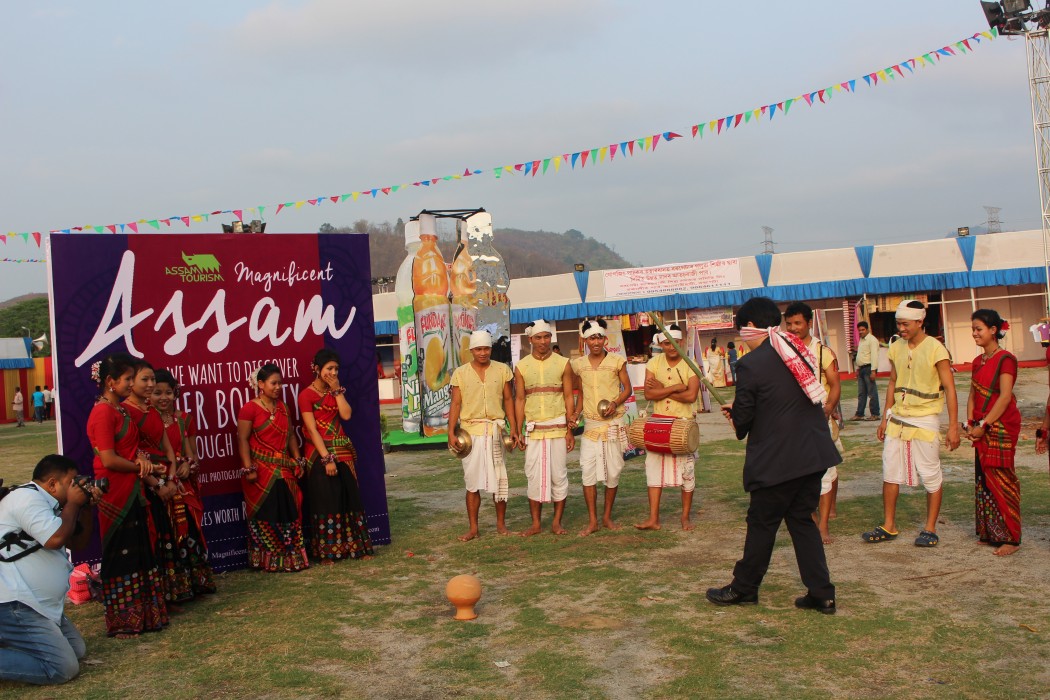
Tourist plays a traditional Assamese game. You are blindfolded, spun around a few times to disorient, and then you have to guess where the pot is – and hit it once with a stick. Great for laughs (yes, I did it, too)!
Towering over crowd is my fabulous and trusted guide, Dipankar Borkakati, who took good care of me. Thank you, Dipankar.
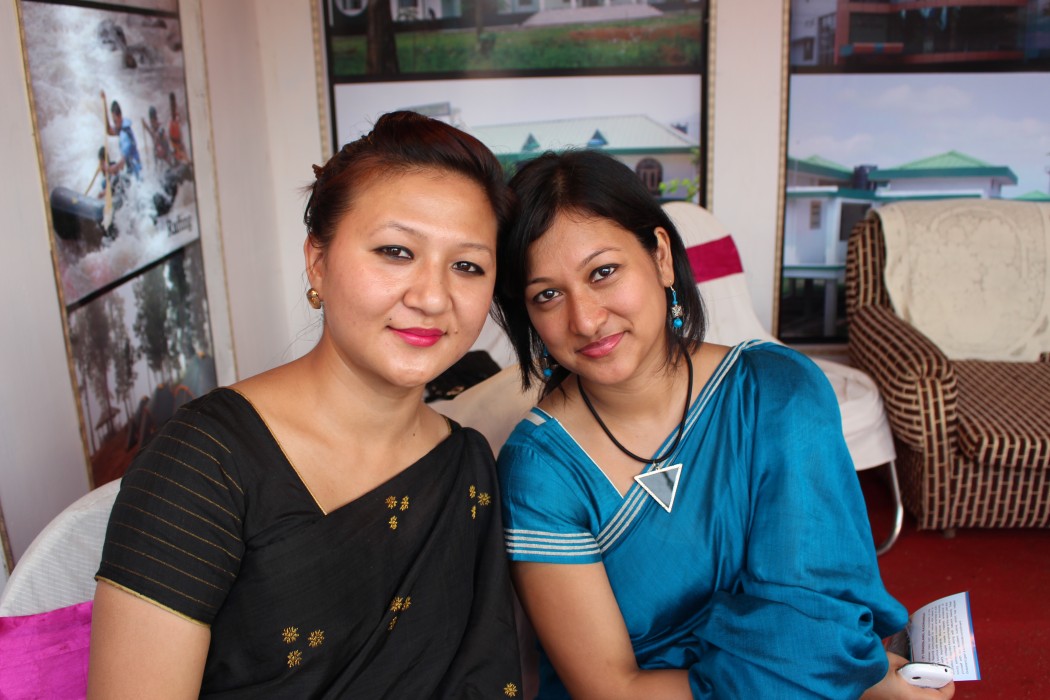
Lovely women from Assam Tourism managing the heat and humidity better than me.
My guides, transportation and accommodations in India were provided by Vasco Travel, whose team worked tirelessly on perfecting every detail, even checking in with me daily.
Where to Stay: Hotel Dynasty (4 star) is situated on the banks of river Brahamputra, and in the business centre of Guwahati, Assam, with facilities including a spa, health club, bar and restaurant, and more. Rooms from $106 CDN and up (www.DynastyHotel.in).
***
Read my first article about my India travels here.
Read my Q&A with India travel expert, Vikas Abbott from Vasco Travel.
Stay tuned for the next article in my series on India…
***
For more information about Rongali Festival and 2016 plans, visit www.RongaliAssam.com.
Traveling to India? Vasco Travel (www.vascotravel.net), based in Delhi, is the industry leader in in-bound travel to India (in Canada, Vasco is represented by Canadian Travel Services www.CanadianTravelServices.ca). For flights, visit Air India (www.airIndia.in), a Star Alliance Member (my route was Toronto-London-Delhi-Guwahati). Resources: India Tourism (www.IncredibleIndia.org) and Assam Tourism (www.AssamTourism.gov.in).
Traveling to India? Here’s expert advice from Vasco Travel
 SHANNON’S TRAVEL BAG: travel tips for women
SHANNON’S TRAVEL BAG: travel tips for women
Shannon’s Q&A with expert on India travel, Vikas Abbott from Vasco Travel, based in Delhi.
This is part one of a series of articles.
As I pack my bags for India, my excitement is growing by the minute about my upcoming visit to this vast, colourful and diverse country that I have longed to explore. With India being so newsworthy these days, particularly with the release of the film India’s Daughter, travel to the country is at the forefront.
So what is the best way for travelers to experience India?
I turned to the leading experts in travel to India, Vasco Travel, an award-winning, family-run travel company based in Delhi, and recipient of the National Tourism Award, and Best Experiential Tour Operator award. What intrigues me about Vasco Travel is their idea of “responsible tourism,” and given that they have been in the travel business for more than 3 generations, I believed there is some wisdom to uncover about how to best experience this country and culture. So I asked Vikas Abbott, Vasco Travel’s Managing Director, some questions that provide great insight. If India is on your radar screen, read on.
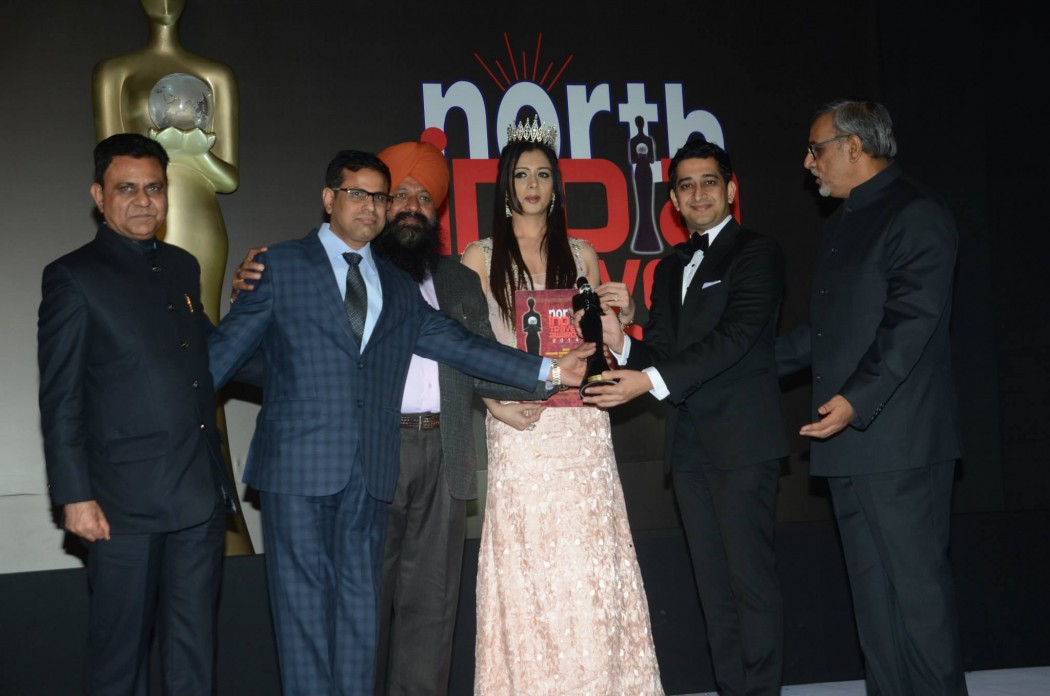 (Vasco Travels receiving award)
(Vasco Travels receiving award)
1. What is the growing trend in the industry?
VA: Travel to Indian sub-continent is witnessing a major shift from traditional to experiential, giving a whole new dimension to the tourism industry. Seasoned travelers from the western world are looking for more authentic and real time experiences that will inspire them, and show them a different perspective of living in peace and harmony.
This transition has thrown a new challenge to the travel industry experts who are now busy designing out-of-the-box experiential packages to woo the travelers from across the globe. Travel concepts like culinary, wellness, women travel, sustainable/eco tourism and golf tourism are gathering momentum in India and hoteliers are constructing new properties in-line with these concepts. Destination Management Companies (DMCs) like Vasco Travel are frontrunners in promoting experiential packages to their overseas clients with the sole aim of making their Indian experience exotic and memorable… a Once-in-a-Lifetime experience.
2. What is responsible tourism?
VA: Responsible Tourism involves traveling to a defined location that demonstrates eco-friendly practices like efficient management of energy, waste and water, and contributes to the welfare of local community by creating employment opportunities and providing education and sanitation to the underprivileged. It is increasingly becoming important to promote Responsible Tourism in India to generate awareness amongst masses towards eco-friendly practices, which would go a long way in improving the tourism infrastructure of off-beat destinations and add value to overall travel experience of the visitors. Tour operators and hoteliers have taken the collective responsibility to promote this initiative in order to maximize the underlying tourism potential of the country.
I am the 3rd generation in the Indian travel industry and over the years, we realized that we need to give back to the society. I believe it should be done at the grass root level. Besides using re-cycled paper for all our brochures, we are promoting hotels that involve the local communities that help them generate employment and promote the dying arts in India. The company has been actively involved with an organization, Grow-Trees, that plants trees on community or public land. We plant trees for each of the guests traveling with Vasco Travel and give them an e-certificate. For some of our overseas partners, they calculate the carbon emissions and we plant trees on their behalf. http://www.grow-trees.com/corporates/corporate_supporters.aspx
Since last 5 years, we have been financially supporting 02Kids in their education through SOS Villages of India.
3. What is the most popular travel theme that consumers are seeking?
VA: Travelers to India from the western world are seeking varied travel experiences as the country has so much to offer in terms of tourism under one roof. Wellness, sustainable, spiritual and culinary travel have become a new found passion for the global traveler to India.
4. Tell me about your top wellness packages and why they are so popular.
VA: Indian wellness therapies have captured the imagination of international travelers from around the world who come here to rejuvenate themselves with time-tested Ayurvedic treatments. Vasco Travel has synergized with some of the best Wellness Spas and offers Spa & Wellness holidays across the county. Of all the places, Kerala is the most famous for offering traditional holistic treatments to the discerning guests.
5. What makes Vasco Travel unique – and what is its mission?
VA: Vasco Travel has designed some unique experiences in different locations across India to amaze and delight our guests with these experiences. Our mission is to design out of the box experiences that offer a different picture of India that cannot be seen in images or read in travelogues. Its uniqueness can be cherished only by going through these experiences. Some of the experiences we offer include a meal with Indian families, unique dining experiences, culinary and heritage walks in selected cities, and vintage car rides.
6. What makes India such a special destination?
VA: India offers a blend of old world charm and modernity to the visitors. Enchanting Himalayas in the north, sprawling beaches of Goa, Kerala backwaters and countryside, mesmerizing sand dunes of Rajasthan, exotic wildlife, holy rivers and majestic temples are bound to astound your senses with mysticism while state-of-the-art hotels, airports, swanky shopping malls, corporate towers and plush homestays offer modern creature comforts and give you a glimpse of changing India. If you are looking for a transcendental experience with a heady mix of spirituality and luxury, then India is the place to be.
7. What is “experiential travel” and why is it important or relevant?
VA: A country’s uniqueness and dynamism is known by the experiences it has to offer to its visitors. The modern world is evolving at a fast pace and the awakened travelers want to spend their money on a travel experience only if it excites them. Just the run of the mill touristy circuit doesn’t motivate them anymore. Therefore, it is crucial for tour operators to project their country on a different platform altogether and attract visitors by exploring the unexplored territories.
8. Since the film “India’s Daughter” is so topical at the moment, issues about women’s safety in India is being discussed all over the media and social media. Is India safe for women travellers? What does your company do to ensure the safety of your women guests/customers?
VA: Women all over India travel without fear to any part of the country by using all means of transport. We at Vasco Travel realize that our women guests have to be given special attention, and therefore we take every possible measure for their safe passage and entry and exit out of the country. Our drivers are well-behaved, professional and are hired only after doing background checks. The accommodations we book for our guests across India have enough security measures in place to ensure safety of our women guests. Not only our women travellers, but every guest is met upon arrival/departure by our office representatives in every city. Our tour escorts are well trained to handle emergencies and SOS situations. We are just a call away.
In Canada, Vasco Travel is represented by Canadian Travel Services marketing and communication agency, led by CEO, Ajay Tandon.
More information about Vasco Travel, click here.
This International Women’s Day, be thankful for the UN
On this International Women’s Day, I am thankful for the United Nations and its important work around the globe. The United Nations, which celebrates its 70th anniversary this year, touches the lives of every woman – and in every aspect of her life.
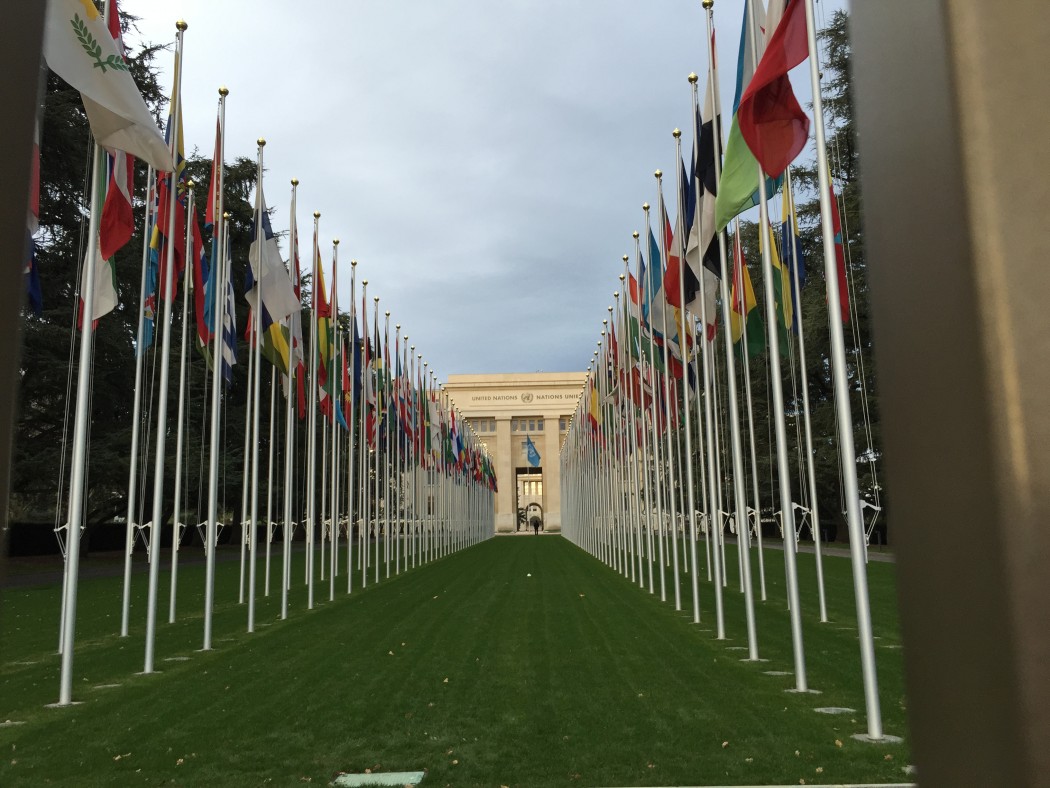
I recently had the privilege of visiting the United Nations European Headquarters in Geneva, Switzerland, the world’s capital of peace. The UN is located in the magnificent Palais des Nations, a marvel of architecture situated on a sprawling property with a breathtaking view of Lake Geneva and the Alps. Much peace-making and humanitarian history has been made there and if you’ve never been, put it on your love list.
This visit not only opened my eyes, it is changing the course of my life.
“The United Nations has an impact on everyone on the planet, from the time we get up to the time we go to bed, for both women and men,” says Corinne Momal-Vanian, Director, Information Service and Spokesperson for United Nations Geneva. “From health, to the world of work, to mobile phones, to patents.”
The UN has a key role in ensuring women’s rights are protected and promoted, as well as ending discrimination against women. Though the education of girls in underdeveloped countries has been a major area of focus, in recent years, there has been an interesting shift in priorities. According to Momal-Vanian, in the last 10-15 years, the UN has made great progress with the education of girls, particularly at the primary school level. “We’re near parity at primary school, which is huge progress because that’s the basis for everything.”
(Corinne Momal-Vanian, pictured in her office at the UN Geneva)
While progress has been made in education, there are now greater challenges ahead in other areas.
Maternal health is now one of the biggest areas of work of the UN, with the World Health Organization and UNICEF, a few of the many organizations that are part of the UN family. And for good reason. “Death in childbirth and death during pregnancy is at an unacceptable level,” adds Momal-Vanian.
The numbers are bleak. According to the World Health Organization, 1,000 women die every day of the consequences of pregnancy and childbirth, including severe bleeding after childbirth, infections, hypertensive disorders and unsafe abortions.
While maternal health is a top priority, according to Momal-Vanian, ending discrimination and protecting women’s rights in general, is also one of its biggest challenges. In her view, we need to be firmer with countries’ commitments to ending discrimination against women.
And so, this International Women’s Day, let’s not only celebrate the advancement and protection of our rights, let’s do our bit to help stop women all over the world from dying during childbirth and pregnancy.
Lastly, the United Nations in Geneva is holding a number events throughout the year to mark its 70th anniversary. For more information, visit the UN website and Geneva Tourism.
Shannon Skinner is an award-winning inspirational speaker, writer, and host and producer of the television and online series www.ExtraordinaryWomenTV.com.


